Urban Tourism Development
VerifiedAdded on 2020/12/09
|26
|5383
|166
Project
AI Summary
This project examines the development of urban tourism and its influence on customer satisfaction, focusing on the Imperial War Museum London. It analyzes the concept of urban tourism, its importance in London, and its influence on the city's growth and development. The project utilizes a descriptive research design and includes data analysis from a questionnaire survey.
Contribute Materials
Your contribution can guide someone’s learning journey. Share your
documents today.
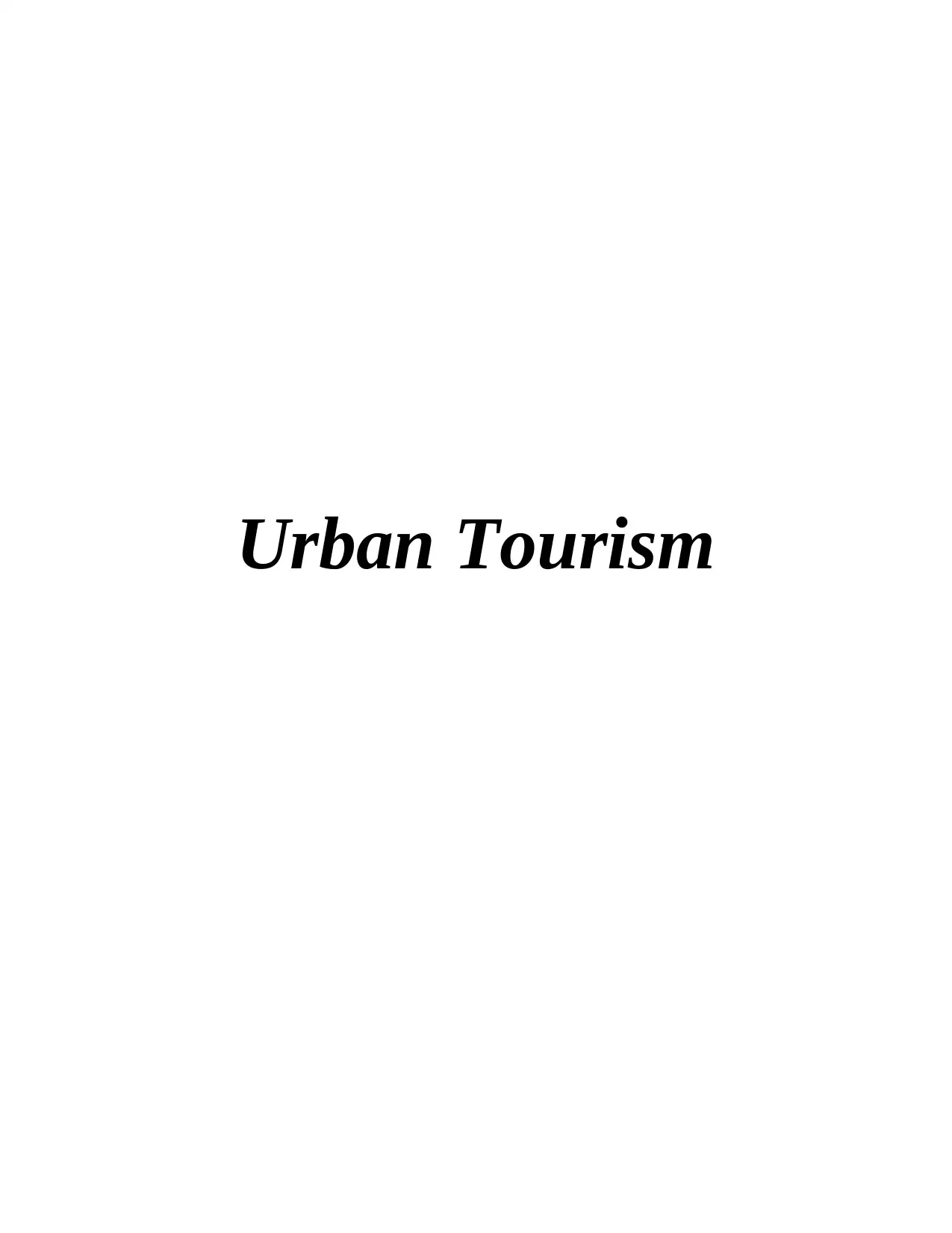
Urban Tourism
Secure Best Marks with AI Grader
Need help grading? Try our AI Grader for instant feedback on your assignments.
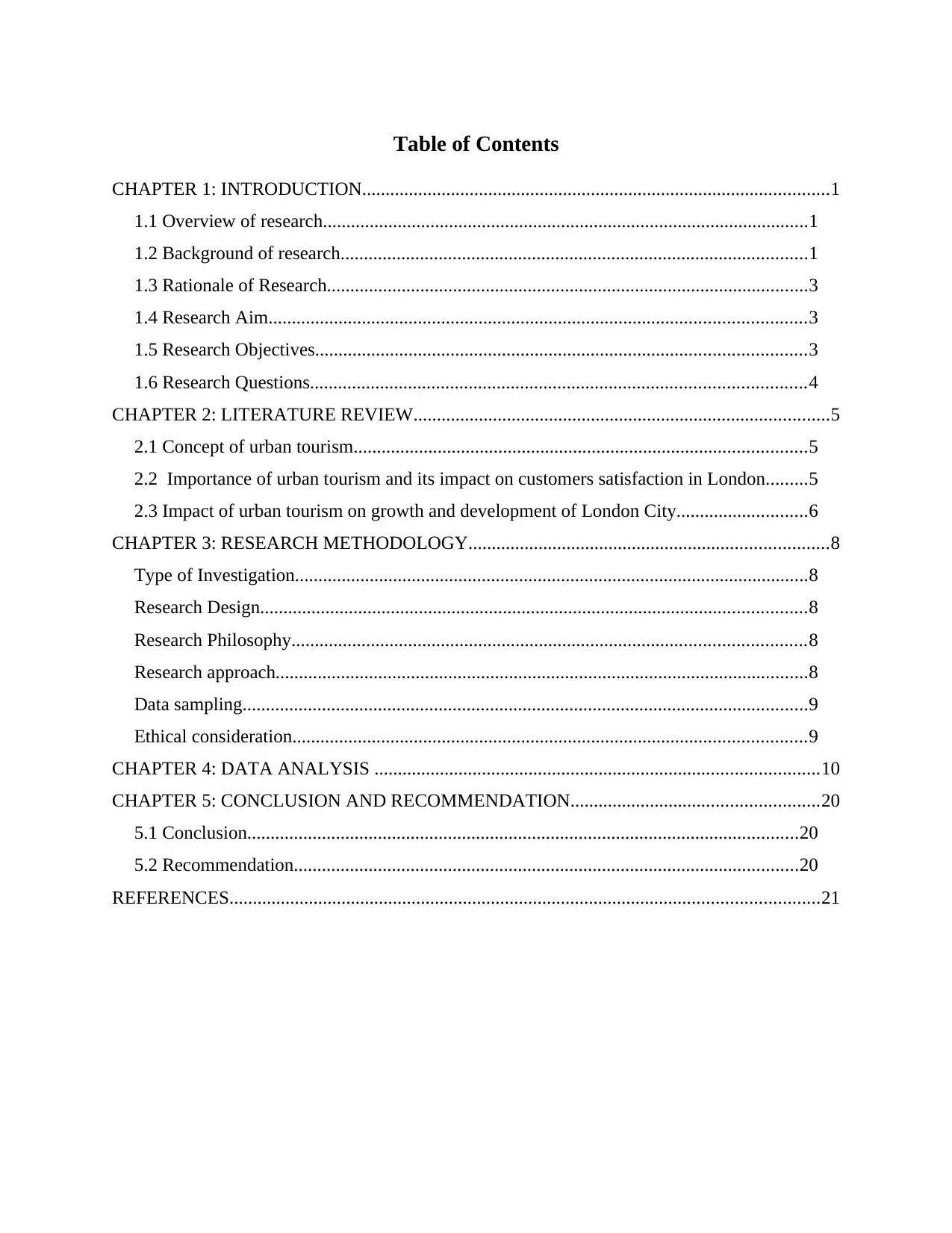
Table of Contents
CHAPTER 1: INTRODUCTION....................................................................................................1
1.1 Overview of research........................................................................................................1
1.2 Background of research....................................................................................................1
1.3 Rationale of Research.......................................................................................................3
1.4 Research Aim...................................................................................................................3
1.5 Research Objectives.........................................................................................................3
1.6 Research Questions..........................................................................................................4
CHAPTER 2: LITERATURE REVIEW.........................................................................................5
2.1 Concept of urban tourism.................................................................................................5
2.2 Importance of urban tourism and its impact on customers satisfaction in London.........5
2.3 Impact of urban tourism on growth and development of London City............................6
CHAPTER 3: RESEARCH METHODOLOGY.............................................................................8
Type of Investigation..............................................................................................................8
Research Design.....................................................................................................................8
Research Philosophy..............................................................................................................8
Research approach..................................................................................................................8
Data sampling.........................................................................................................................9
Ethical consideration..............................................................................................................9
CHAPTER 4: DATA ANALYSIS ...............................................................................................10
CHAPTER 5: CONCLUSION AND RECOMMENDATION.....................................................20
5.1 Conclusion......................................................................................................................20
5.2 Recommendation............................................................................................................20
REFERENCES..............................................................................................................................21
CHAPTER 1: INTRODUCTION....................................................................................................1
1.1 Overview of research........................................................................................................1
1.2 Background of research....................................................................................................1
1.3 Rationale of Research.......................................................................................................3
1.4 Research Aim...................................................................................................................3
1.5 Research Objectives.........................................................................................................3
1.6 Research Questions..........................................................................................................4
CHAPTER 2: LITERATURE REVIEW.........................................................................................5
2.1 Concept of urban tourism.................................................................................................5
2.2 Importance of urban tourism and its impact on customers satisfaction in London.........5
2.3 Impact of urban tourism on growth and development of London City............................6
CHAPTER 3: RESEARCH METHODOLOGY.............................................................................8
Type of Investigation..............................................................................................................8
Research Design.....................................................................................................................8
Research Philosophy..............................................................................................................8
Research approach..................................................................................................................8
Data sampling.........................................................................................................................9
Ethical consideration..............................................................................................................9
CHAPTER 4: DATA ANALYSIS ...............................................................................................10
CHAPTER 5: CONCLUSION AND RECOMMENDATION.....................................................20
5.1 Conclusion......................................................................................................................20
5.2 Recommendation............................................................................................................20
REFERENCES..............................................................................................................................21

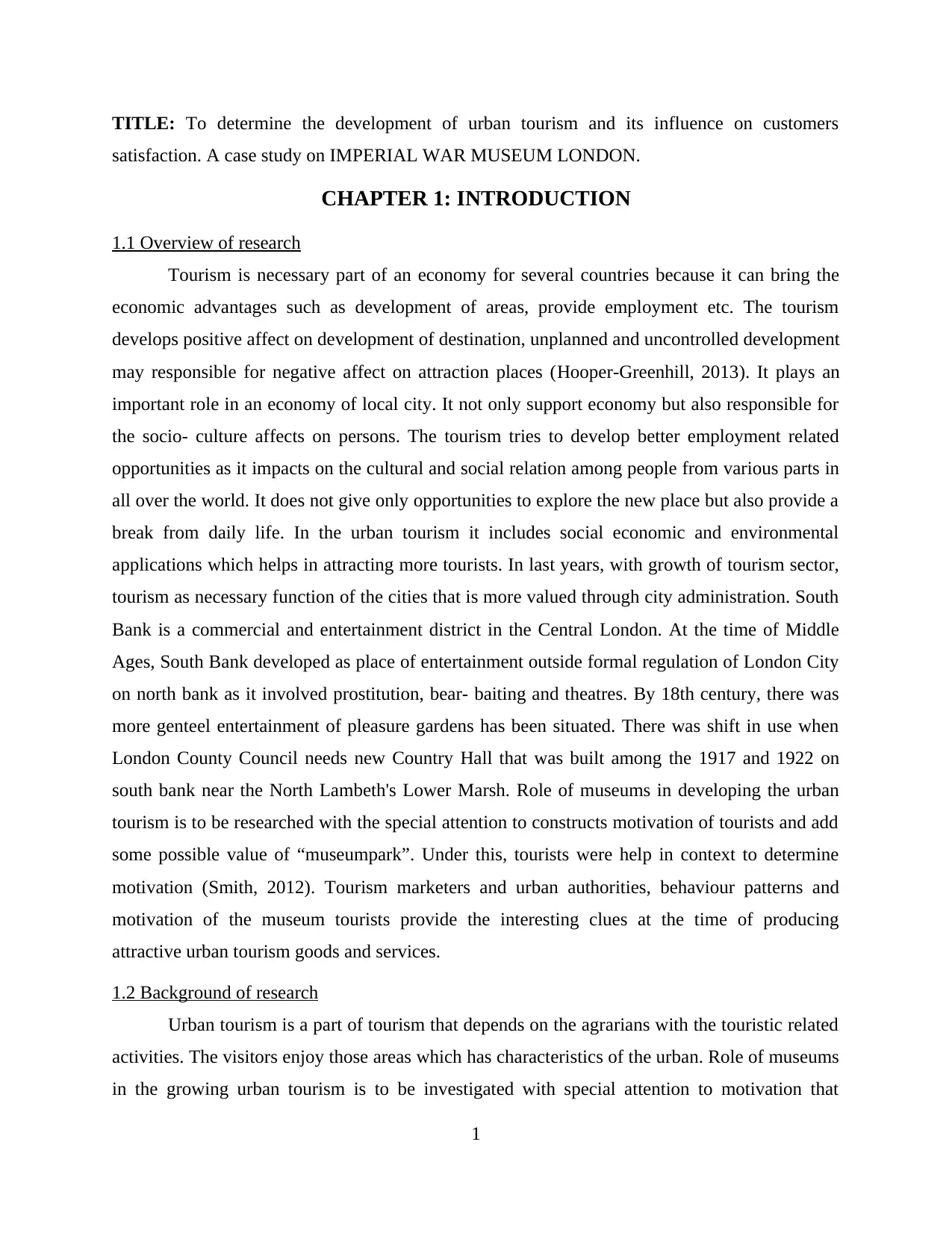
TITLE: To determine the development of urban tourism and its influence on customers
satisfaction. A case study on IMPERIAL WAR MUSEUM LONDON.
CHAPTER 1: INTRODUCTION
1.1 Overview of research
Tourism is necessary part of an economy for several countries because it can bring the
economic advantages such as development of areas, provide employment etc. The tourism
develops positive affect on development of destination, unplanned and uncontrolled development
may responsible for negative affect on attraction places (Hooper-Greenhill, 2013). It plays an
important role in an economy of local city. It not only support economy but also responsible for
the socio- culture affects on persons. The tourism tries to develop better employment related
opportunities as it impacts on the cultural and social relation among people from various parts in
all over the world. It does not give only opportunities to explore the new place but also provide a
break from daily life. In the urban tourism it includes social economic and environmental
applications which helps in attracting more tourists. In last years, with growth of tourism sector,
tourism as necessary function of the cities that is more valued through city administration. South
Bank is a commercial and entertainment district in the Central London. At the time of Middle
Ages, South Bank developed as place of entertainment outside formal regulation of London City
on north bank as it involved prostitution, bear- baiting and theatres. By 18th century, there was
more genteel entertainment of pleasure gardens has been situated. There was shift in use when
London County Council needs new Country Hall that was built among the 1917 and 1922 on
south bank near the North Lambeth's Lower Marsh. Role of museums in developing the urban
tourism is to be researched with the special attention to constructs motivation of tourists and add
some possible value of “museumpark”. Under this, tourists were help in context to determine
motivation (Smith, 2012). Tourism marketers and urban authorities, behaviour patterns and
motivation of the museum tourists provide the interesting clues at the time of producing
attractive urban tourism goods and services.
1.2 Background of research
Urban tourism is a part of tourism that depends on the agrarians with the touristic related
activities. The visitors enjoy those areas which has characteristics of the urban. Role of museums
in the growing urban tourism is to be investigated with special attention to motivation that
1
satisfaction. A case study on IMPERIAL WAR MUSEUM LONDON.
CHAPTER 1: INTRODUCTION
1.1 Overview of research
Tourism is necessary part of an economy for several countries because it can bring the
economic advantages such as development of areas, provide employment etc. The tourism
develops positive affect on development of destination, unplanned and uncontrolled development
may responsible for negative affect on attraction places (Hooper-Greenhill, 2013). It plays an
important role in an economy of local city. It not only support economy but also responsible for
the socio- culture affects on persons. The tourism tries to develop better employment related
opportunities as it impacts on the cultural and social relation among people from various parts in
all over the world. It does not give only opportunities to explore the new place but also provide a
break from daily life. In the urban tourism it includes social economic and environmental
applications which helps in attracting more tourists. In last years, with growth of tourism sector,
tourism as necessary function of the cities that is more valued through city administration. South
Bank is a commercial and entertainment district in the Central London. At the time of Middle
Ages, South Bank developed as place of entertainment outside formal regulation of London City
on north bank as it involved prostitution, bear- baiting and theatres. By 18th century, there was
more genteel entertainment of pleasure gardens has been situated. There was shift in use when
London County Council needs new Country Hall that was built among the 1917 and 1922 on
south bank near the North Lambeth's Lower Marsh. Role of museums in developing the urban
tourism is to be researched with the special attention to constructs motivation of tourists and add
some possible value of “museumpark”. Under this, tourists were help in context to determine
motivation (Smith, 2012). Tourism marketers and urban authorities, behaviour patterns and
motivation of the museum tourists provide the interesting clues at the time of producing
attractive urban tourism goods and services.
1.2 Background of research
Urban tourism is a part of tourism that depends on the agrarians with the touristic related
activities. The visitors enjoy those areas which has characteristics of the urban. Role of museums
in the growing urban tourism is to be investigated with special attention to motivation that
1
Secure Best Marks with AI Grader
Need help grading? Try our AI Grader for instant feedback on your assignments.
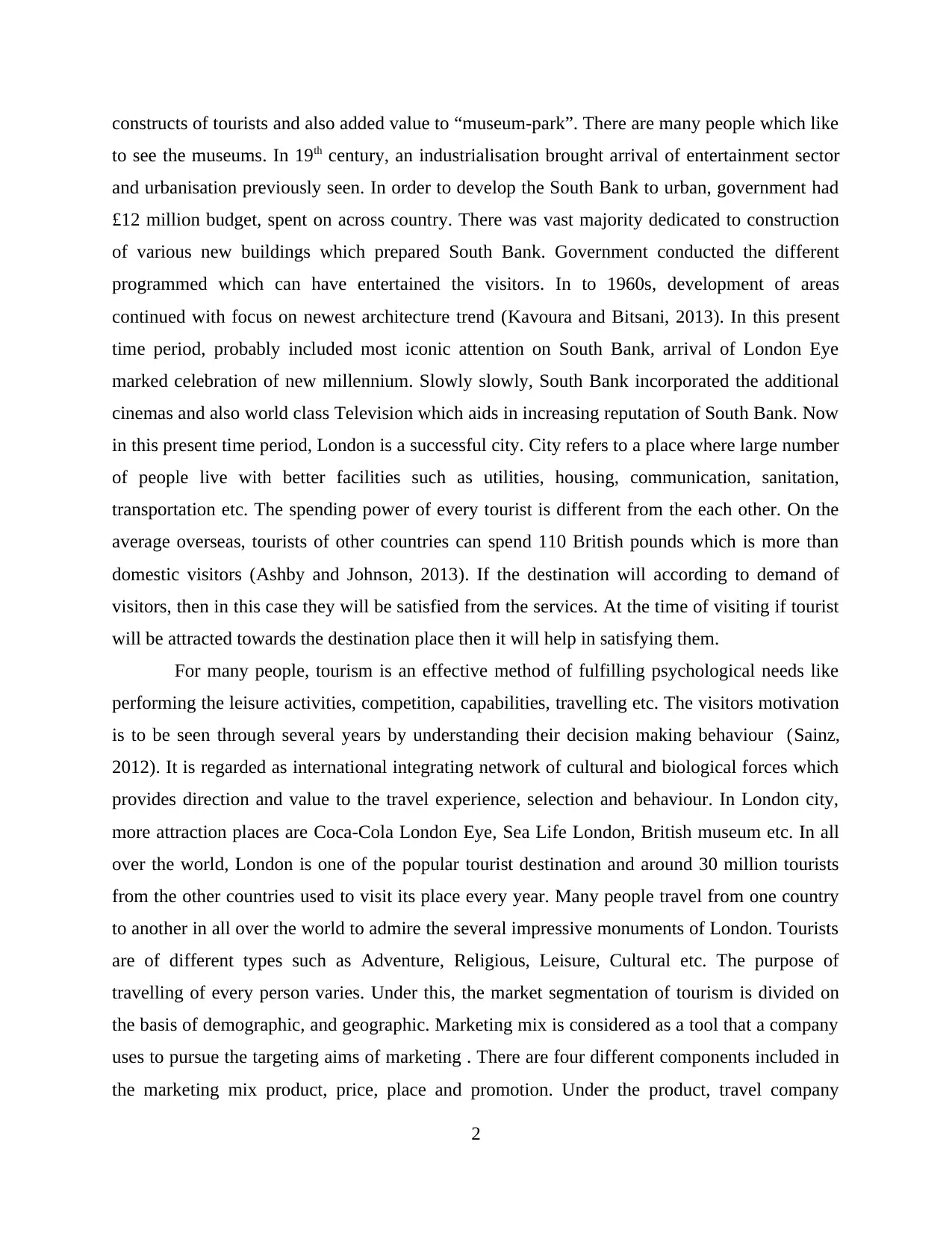
constructs of tourists and also added value to “museum-park”. There are many people which like
to see the museums. In 19th century, an industrialisation brought arrival of entertainment sector
and urbanisation previously seen. In order to develop the South Bank to urban, government had
£12 million budget, spent on across country. There was vast majority dedicated to construction
of various new buildings which prepared South Bank. Government conducted the different
programmed which can have entertained the visitors. In to 1960s, development of areas
continued with focus on newest architecture trend (Kavoura and Bitsani, 2013). In this present
time period, probably included most iconic attention on South Bank, arrival of London Eye
marked celebration of new millennium. Slowly slowly, South Bank incorporated the additional
cinemas and also world class Television which aids in increasing reputation of South Bank. Now
in this present time period, London is a successful city. City refers to a place where large number
of people live with better facilities such as utilities, housing, communication, sanitation,
transportation etc. The spending power of every tourist is different from the each other. On the
average overseas, tourists of other countries can spend 110 British pounds which is more than
domestic visitors (Ashby and Johnson, 2013). If the destination will according to demand of
visitors, then in this case they will be satisfied from the services. At the time of visiting if tourist
will be attracted towards the destination place then it will help in satisfying them.
For many people, tourism is an effective method of fulfilling psychological needs like
performing the leisure activities, competition, capabilities, travelling etc. The visitors motivation
is to be seen through several years by understanding their decision making behaviour (Sainz,
2012). It is regarded as international integrating network of cultural and biological forces which
provides direction and value to the travel experience, selection and behaviour. In London city,
more attraction places are Coca-Cola London Eye, Sea Life London, British museum etc. In all
over the world, London is one of the popular tourist destination and around 30 million tourists
from the other countries used to visit its place every year. Many people travel from one country
to another in all over the world to admire the several impressive monuments of London. Tourists
are of different types such as Adventure, Religious, Leisure, Cultural etc. The purpose of
travelling of every person varies. Under this, the market segmentation of tourism is divided on
the basis of demographic, and geographic. Marketing mix is considered as a tool that a company
uses to pursue the targeting aims of marketing . There are four different components included in
the marketing mix product, price, place and promotion. Under the product, travel company
2
to see the museums. In 19th century, an industrialisation brought arrival of entertainment sector
and urbanisation previously seen. In order to develop the South Bank to urban, government had
£12 million budget, spent on across country. There was vast majority dedicated to construction
of various new buildings which prepared South Bank. Government conducted the different
programmed which can have entertained the visitors. In to 1960s, development of areas
continued with focus on newest architecture trend (Kavoura and Bitsani, 2013). In this present
time period, probably included most iconic attention on South Bank, arrival of London Eye
marked celebration of new millennium. Slowly slowly, South Bank incorporated the additional
cinemas and also world class Television which aids in increasing reputation of South Bank. Now
in this present time period, London is a successful city. City refers to a place where large number
of people live with better facilities such as utilities, housing, communication, sanitation,
transportation etc. The spending power of every tourist is different from the each other. On the
average overseas, tourists of other countries can spend 110 British pounds which is more than
domestic visitors (Ashby and Johnson, 2013). If the destination will according to demand of
visitors, then in this case they will be satisfied from the services. At the time of visiting if tourist
will be attracted towards the destination place then it will help in satisfying them.
For many people, tourism is an effective method of fulfilling psychological needs like
performing the leisure activities, competition, capabilities, travelling etc. The visitors motivation
is to be seen through several years by understanding their decision making behaviour (Sainz,
2012). It is regarded as international integrating network of cultural and biological forces which
provides direction and value to the travel experience, selection and behaviour. In London city,
more attraction places are Coca-Cola London Eye, Sea Life London, British museum etc. In all
over the world, London is one of the popular tourist destination and around 30 million tourists
from the other countries used to visit its place every year. Many people travel from one country
to another in all over the world to admire the several impressive monuments of London. Tourists
are of different types such as Adventure, Religious, Leisure, Cultural etc. The purpose of
travelling of every person varies. Under this, the market segmentation of tourism is divided on
the basis of demographic, and geographic. Marketing mix is considered as a tool that a company
uses to pursue the targeting aims of marketing . There are four different components included in
the marketing mix product, price, place and promotion. Under the product, travel company
2

should provide all the necessary facilities to visitors so that they can travel without any issue.
Tourists want travelling packages as well as services on reasonable cost. It is necessary that the
tourist destinations should be according to the demands and needs of visitors so that they are
satisfied (Bryce, Gorman and Baxter, 2013). In order to aware people about the destination
places, government use different methods such as websites, print media, social media etc.
1.3 Rationale of Research
The main purpose behind conducting this research is to know about the development of
urban tourism and its influence on customers satisfaction. The satisfaction level of consumers is
necessary for development and growth of the tourism sector. City marketing refers to a technique
of promoting the city with main objective is to encourage the activities through which minds of
tourists can be attracted. It is helpful in changing perceptions of externals about the city which
further encourage tourism, enable the business relocation etc. Before urbanisation, South Bank
area was not famous and people do not like to visit that place but after develop the many
attractive buildings, travel places etc. Many people take interest to travel South Bank (Vale,
2014). It helps in increasing the number of visitors. From last five years, there has been many
changes taking place at South Bank which increases its effectiveness. It includes development of
marketplace and its infrastructure which helps in assisting people to visit this place. This market
has generated potential where new food vendors can open their restaurants and earn an effective
profitability. Along with this, in terms of infrastructure, there has an accessibility of Borough
High Street in South Bank due to heavy efforts of new glass-fronted section. Restaurants and
cafes offer a wide variety of rich continental food to customers on affordable price rates (Isaac
and Budryte-Ausiejiene, 2015). Moreover, many traders have opened outlet in marketplace of
South Bank where a tourists can find old and traditional fashioned clothes also.
1.4 Research Aim
To determine the development of urban tourism and its influence on customers
satisfaction. A case study on IMPERIAL WAR MUSEUM LONDON.
1.5 Research Objectives
To analyse the concept of urban tourism.
To Identify the importance of urban tourism and its impact on customers satisfaction in
London.
3
Tourists want travelling packages as well as services on reasonable cost. It is necessary that the
tourist destinations should be according to the demands and needs of visitors so that they are
satisfied (Bryce, Gorman and Baxter, 2013). In order to aware people about the destination
places, government use different methods such as websites, print media, social media etc.
1.3 Rationale of Research
The main purpose behind conducting this research is to know about the development of
urban tourism and its influence on customers satisfaction. The satisfaction level of consumers is
necessary for development and growth of the tourism sector. City marketing refers to a technique
of promoting the city with main objective is to encourage the activities through which minds of
tourists can be attracted. It is helpful in changing perceptions of externals about the city which
further encourage tourism, enable the business relocation etc. Before urbanisation, South Bank
area was not famous and people do not like to visit that place but after develop the many
attractive buildings, travel places etc. Many people take interest to travel South Bank (Vale,
2014). It helps in increasing the number of visitors. From last five years, there has been many
changes taking place at South Bank which increases its effectiveness. It includes development of
marketplace and its infrastructure which helps in assisting people to visit this place. This market
has generated potential where new food vendors can open their restaurants and earn an effective
profitability. Along with this, in terms of infrastructure, there has an accessibility of Borough
High Street in South Bank due to heavy efforts of new glass-fronted section. Restaurants and
cafes offer a wide variety of rich continental food to customers on affordable price rates (Isaac
and Budryte-Ausiejiene, 2015). Moreover, many traders have opened outlet in marketplace of
South Bank where a tourists can find old and traditional fashioned clothes also.
1.4 Research Aim
To determine the development of urban tourism and its influence on customers
satisfaction. A case study on IMPERIAL WAR MUSEUM LONDON.
1.5 Research Objectives
To analyse the concept of urban tourism.
To Identify the importance of urban tourism and its impact on customers satisfaction in
London.
3
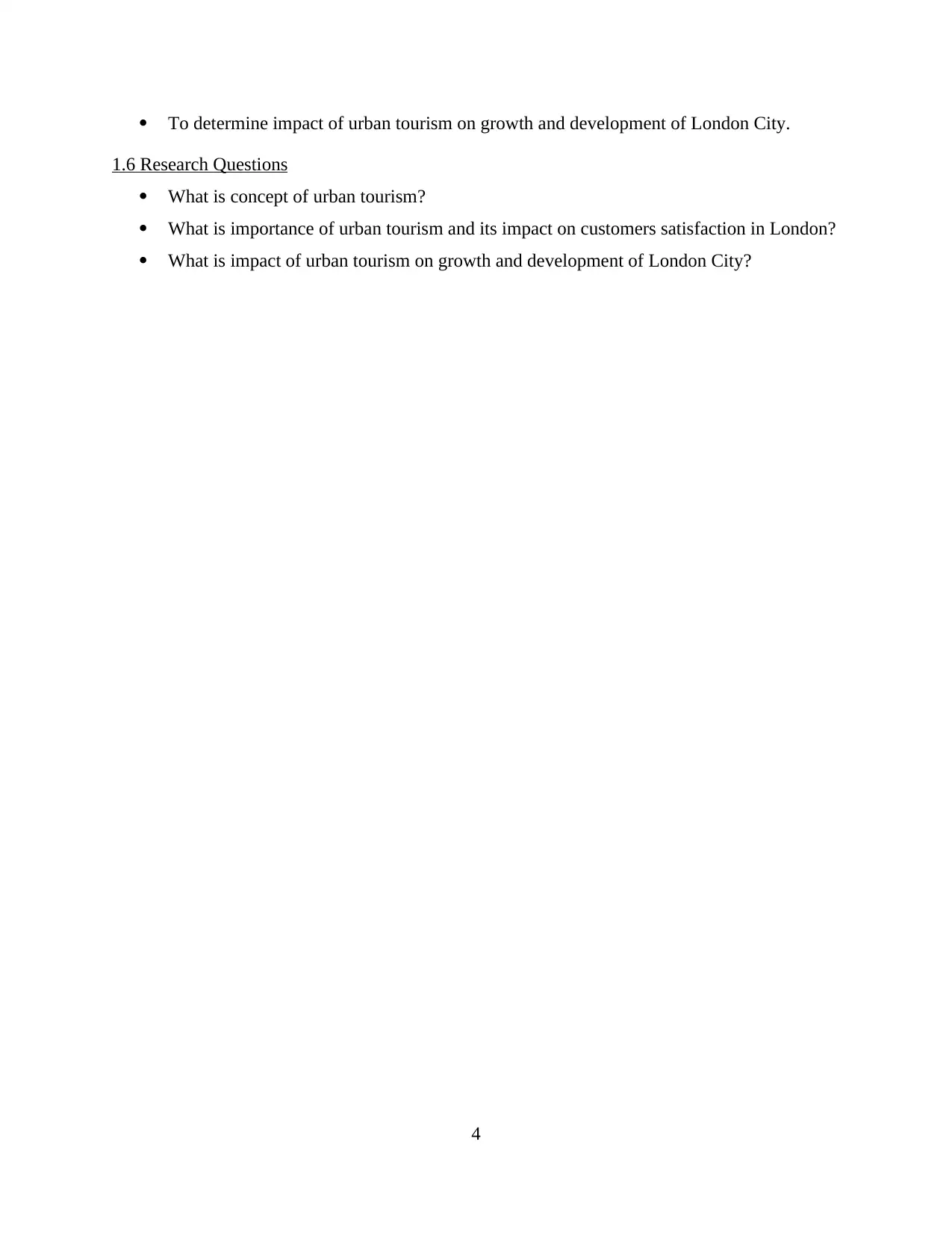
To determine impact of urban tourism on growth and development of London City.
1.6 Research Questions
What is concept of urban tourism?
What is importance of urban tourism and its impact on customers satisfaction in London?
What is impact of urban tourism on growth and development of London City?
4
1.6 Research Questions
What is concept of urban tourism?
What is importance of urban tourism and its impact on customers satisfaction in London?
What is impact of urban tourism on growth and development of London City?
4
Paraphrase This Document
Need a fresh take? Get an instant paraphrase of this document with our AI Paraphraser

CHAPTER 2: LITERATURE REVIEW
It is main part of research and under this an investigator collect data and information
related to research topic from the various different sources of secondary data such as books,
articles, journals and many others.
2.1 Concept of urban tourism
Urban Tourism concept is broad and it includes all types of entertainment activities
which are conducted in cities. Urban tourism encompasses activities of domestic and
international tourism and local people in the urban areas, contextualized through developed
through infrastructure, natural landscapes, amenities etc. On the basis of view point of Yoshida,
Bui and Lee (2016), it has been stated that Urban areas for an instance cities and towns are the
sources of the traveller’s act as gateways, tourism destinations to some of the other places. Urban
tourism refers to several visitor’s activities under which the city is a major destination as well as
interested place. There is more than 50% population of world that is urbanized, thus features as
well as dynamics of urban tourism are necessary to understand as the drivers of an economy of
global tourism. It is inseparable from economic, technological, social and spatial issued of local
responses and urbanization to globalisation.
The urban tourism gives many benefits to the local people in several different ways such
as provide employment etc. Development of tourism in the urban areas has caused the socio
cultural, environmental and economic. The urban tourism includes various kinds of activities and
people visit the urban cities for the various objectives. They like to travel the tourist’s attractions,
special events, historical buildings, galleries etc. According to Mok, Sparks and Kadampully
(2013), it has been concluded that Urban cities provides many activities to enhance the tourism
and also attract the large number of people. In context to urban tourism, it enhances reputation of
heritage and also determine which are consumers through visitors and residents. Urban tourism is
helpful in support an economy of country and also try to provide the better employment related
opportunities to the local people. It helps in attract the large number of people towards it.
2.2 Importance of urban tourism and its impact on customers satisfaction in London
People has been travel in all around the world with the different reasons. The reasons can
be related to education, business and leisure, it falls in wider categorisation of the tourism
(Importance Of Urban Tourism, 2018). In addition to this, transformation and technological
5
It is main part of research and under this an investigator collect data and information
related to research topic from the various different sources of secondary data such as books,
articles, journals and many others.
2.1 Concept of urban tourism
Urban Tourism concept is broad and it includes all types of entertainment activities
which are conducted in cities. Urban tourism encompasses activities of domestic and
international tourism and local people in the urban areas, contextualized through developed
through infrastructure, natural landscapes, amenities etc. On the basis of view point of Yoshida,
Bui and Lee (2016), it has been stated that Urban areas for an instance cities and towns are the
sources of the traveller’s act as gateways, tourism destinations to some of the other places. Urban
tourism refers to several visitor’s activities under which the city is a major destination as well as
interested place. There is more than 50% population of world that is urbanized, thus features as
well as dynamics of urban tourism are necessary to understand as the drivers of an economy of
global tourism. It is inseparable from economic, technological, social and spatial issued of local
responses and urbanization to globalisation.
The urban tourism gives many benefits to the local people in several different ways such
as provide employment etc. Development of tourism in the urban areas has caused the socio
cultural, environmental and economic. The urban tourism includes various kinds of activities and
people visit the urban cities for the various objectives. They like to travel the tourist’s attractions,
special events, historical buildings, galleries etc. According to Mok, Sparks and Kadampully
(2013), it has been concluded that Urban cities provides many activities to enhance the tourism
and also attract the large number of people. In context to urban tourism, it enhances reputation of
heritage and also determine which are consumers through visitors and residents. Urban tourism is
helpful in support an economy of country and also try to provide the better employment related
opportunities to the local people. It helps in attract the large number of people towards it.
2.2 Importance of urban tourism and its impact on customers satisfaction in London
People has been travel in all around the world with the different reasons. The reasons can
be related to education, business and leisure, it falls in wider categorisation of the tourism
(Importance Of Urban Tourism, 2018). In addition to this, transformation and technological
5
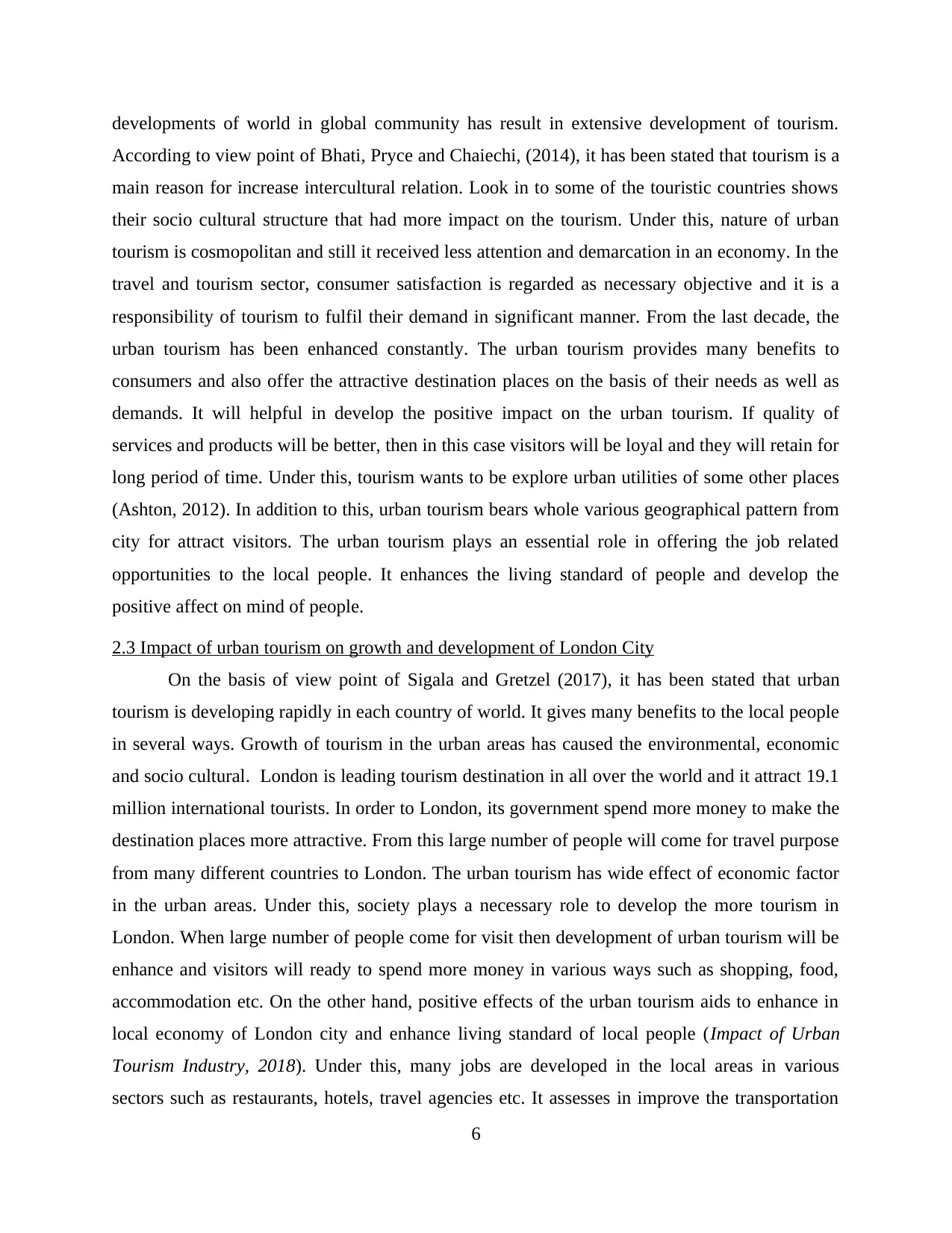
developments of world in global community has result in extensive development of tourism.
According to view point of Bhati, Pryce and Chaiechi, (2014), it has been stated that tourism is a
main reason for increase intercultural relation. Look in to some of the touristic countries shows
their socio cultural structure that had more impact on the tourism. Under this, nature of urban
tourism is cosmopolitan and still it received less attention and demarcation in an economy. In the
travel and tourism sector, consumer satisfaction is regarded as necessary objective and it is a
responsibility of tourism to fulfil their demand in significant manner. From the last decade, the
urban tourism has been enhanced constantly. The urban tourism provides many benefits to
consumers and also offer the attractive destination places on the basis of their needs as well as
demands. It will helpful in develop the positive impact on the urban tourism. If quality of
services and products will be better, then in this case visitors will be loyal and they will retain for
long period of time. Under this, tourism wants to be explore urban utilities of some other places
(Ashton, 2012). In addition to this, urban tourism bears whole various geographical pattern from
city for attract visitors. The urban tourism plays an essential role in offering the job related
opportunities to the local people. It enhances the living standard of people and develop the
positive affect on mind of people.
2.3 Impact of urban tourism on growth and development of London City
On the basis of view point of Sigala and Gretzel (2017), it has been stated that urban
tourism is developing rapidly in each country of world. It gives many benefits to the local people
in several ways. Growth of tourism in the urban areas has caused the environmental, economic
and socio cultural. London is leading tourism destination in all over the world and it attract 19.1
million international tourists. In order to London, its government spend more money to make the
destination places more attractive. From this large number of people will come for travel purpose
from many different countries to London. The urban tourism has wide effect of economic factor
in the urban areas. Under this, society plays a necessary role to develop the more tourism in
London. When large number of people come for visit then development of urban tourism will be
enhance and visitors will ready to spend more money in various ways such as shopping, food,
accommodation etc. On the other hand, positive effects of the urban tourism aids to enhance in
local economy of London city and enhance living standard of local people (Impact of Urban
Tourism Industry, 2018). Under this, many jobs are developed in the local areas in various
sectors such as restaurants, hotels, travel agencies etc. It assesses in improve the transportation
6
According to view point of Bhati, Pryce and Chaiechi, (2014), it has been stated that tourism is a
main reason for increase intercultural relation. Look in to some of the touristic countries shows
their socio cultural structure that had more impact on the tourism. Under this, nature of urban
tourism is cosmopolitan and still it received less attention and demarcation in an economy. In the
travel and tourism sector, consumer satisfaction is regarded as necessary objective and it is a
responsibility of tourism to fulfil their demand in significant manner. From the last decade, the
urban tourism has been enhanced constantly. The urban tourism provides many benefits to
consumers and also offer the attractive destination places on the basis of their needs as well as
demands. It will helpful in develop the positive impact on the urban tourism. If quality of
services and products will be better, then in this case visitors will be loyal and they will retain for
long period of time. Under this, tourism wants to be explore urban utilities of some other places
(Ashton, 2012). In addition to this, urban tourism bears whole various geographical pattern from
city for attract visitors. The urban tourism plays an essential role in offering the job related
opportunities to the local people. It enhances the living standard of people and develop the
positive affect on mind of people.
2.3 Impact of urban tourism on growth and development of London City
On the basis of view point of Sigala and Gretzel (2017), it has been stated that urban
tourism is developing rapidly in each country of world. It gives many benefits to the local people
in several ways. Growth of tourism in the urban areas has caused the environmental, economic
and socio cultural. London is leading tourism destination in all over the world and it attract 19.1
million international tourists. In order to London, its government spend more money to make the
destination places more attractive. From this large number of people will come for travel purpose
from many different countries to London. The urban tourism has wide effect of economic factor
in the urban areas. Under this, society plays a necessary role to develop the more tourism in
London. When large number of people come for visit then development of urban tourism will be
enhance and visitors will ready to spend more money in various ways such as shopping, food,
accommodation etc. On the other hand, positive effects of the urban tourism aids to enhance in
local economy of London city and enhance living standard of local people (Impact of Urban
Tourism Industry, 2018). Under this, many jobs are developed in the local areas in various
sectors such as restaurants, hotels, travel agencies etc. It assesses in improve the transportation
6

facilities and also develop the more opportunities for business. Urban city gives many attraction
places and managed infrastructure related to tourism (Li and Qian, 2017).
7
places and managed infrastructure related to tourism (Li and Qian, 2017).
7
Secure Best Marks with AI Grader
Need help grading? Try our AI Grader for instant feedback on your assignments.
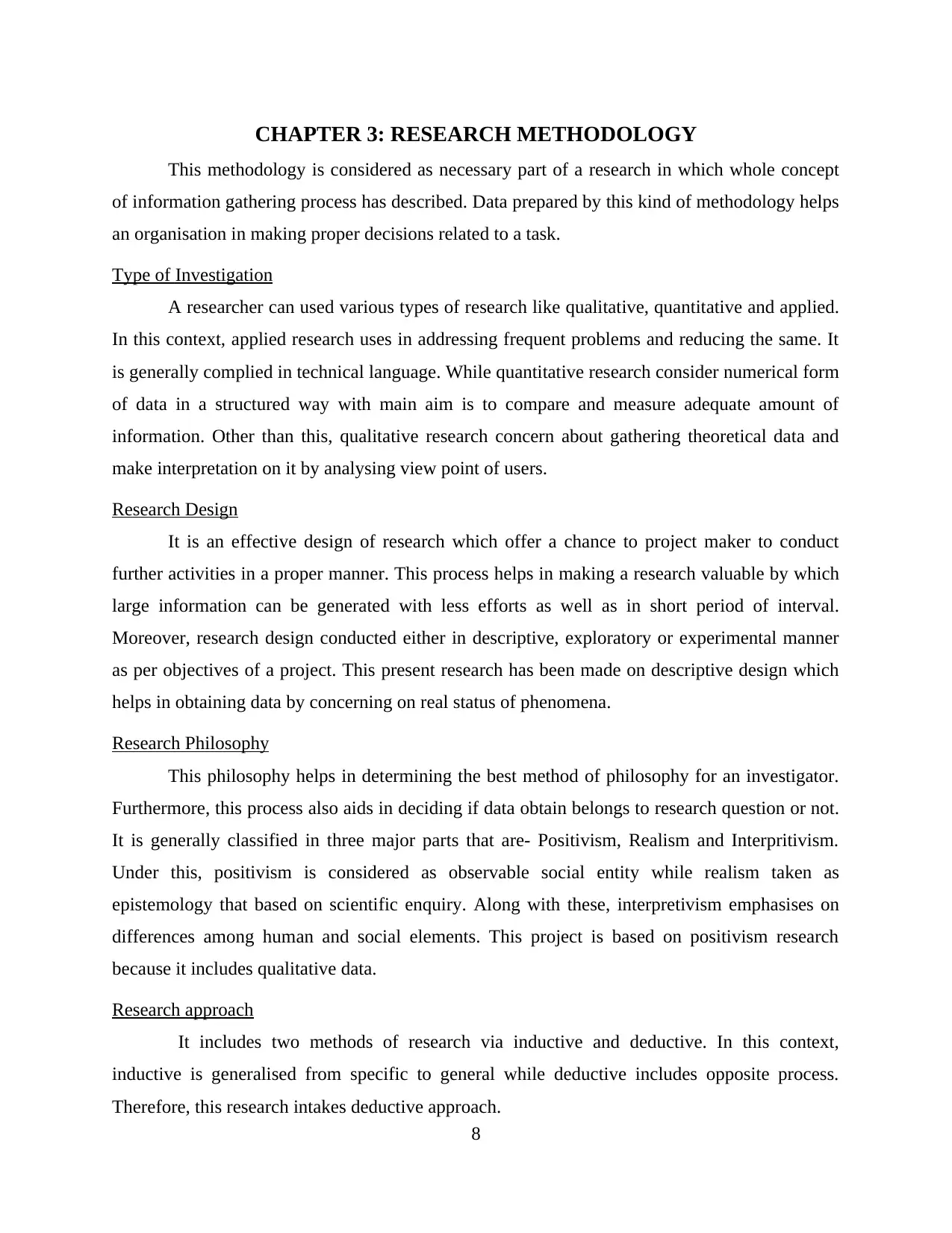
CHAPTER 3: RESEARCH METHODOLOGY
This methodology is considered as necessary part of a research in which whole concept
of information gathering process has described. Data prepared by this kind of methodology helps
an organisation in making proper decisions related to a task.
Type of Investigation
A researcher can used various types of research like qualitative, quantitative and applied.
In this context, applied research uses in addressing frequent problems and reducing the same. It
is generally complied in technical language. While quantitative research consider numerical form
of data in a structured way with main aim is to compare and measure adequate amount of
information. Other than this, qualitative research concern about gathering theoretical data and
make interpretation on it by analysing view point of users.
Research Design
It is an effective design of research which offer a chance to project maker to conduct
further activities in a proper manner. This process helps in making a research valuable by which
large information can be generated with less efforts as well as in short period of interval.
Moreover, research design conducted either in descriptive, exploratory or experimental manner
as per objectives of a project. This present research has been made on descriptive design which
helps in obtaining data by concerning on real status of phenomena.
Research Philosophy
This philosophy helps in determining the best method of philosophy for an investigator.
Furthermore, this process also aids in deciding if data obtain belongs to research question or not.
It is generally classified in three major parts that are- Positivism, Realism and Interpritivism.
Under this, positivism is considered as observable social entity while realism taken as
epistemology that based on scientific enquiry. Along with these, interpretivism emphasises on
differences among human and social elements. This project is based on positivism research
because it includes qualitative data.
Research approach
It includes two methods of research via inductive and deductive. In this context,
inductive is generalised from specific to general while deductive includes opposite process.
Therefore, this research intakes deductive approach.
8
This methodology is considered as necessary part of a research in which whole concept
of information gathering process has described. Data prepared by this kind of methodology helps
an organisation in making proper decisions related to a task.
Type of Investigation
A researcher can used various types of research like qualitative, quantitative and applied.
In this context, applied research uses in addressing frequent problems and reducing the same. It
is generally complied in technical language. While quantitative research consider numerical form
of data in a structured way with main aim is to compare and measure adequate amount of
information. Other than this, qualitative research concern about gathering theoretical data and
make interpretation on it by analysing view point of users.
Research Design
It is an effective design of research which offer a chance to project maker to conduct
further activities in a proper manner. This process helps in making a research valuable by which
large information can be generated with less efforts as well as in short period of interval.
Moreover, research design conducted either in descriptive, exploratory or experimental manner
as per objectives of a project. This present research has been made on descriptive design which
helps in obtaining data by concerning on real status of phenomena.
Research Philosophy
This philosophy helps in determining the best method of philosophy for an investigator.
Furthermore, this process also aids in deciding if data obtain belongs to research question or not.
It is generally classified in three major parts that are- Positivism, Realism and Interpritivism.
Under this, positivism is considered as observable social entity while realism taken as
epistemology that based on scientific enquiry. Along with these, interpretivism emphasises on
differences among human and social elements. This project is based on positivism research
because it includes qualitative data.
Research approach
It includes two methods of research via inductive and deductive. In this context,
inductive is generalised from specific to general while deductive includes opposite process.
Therefore, this research intakes deductive approach.
8
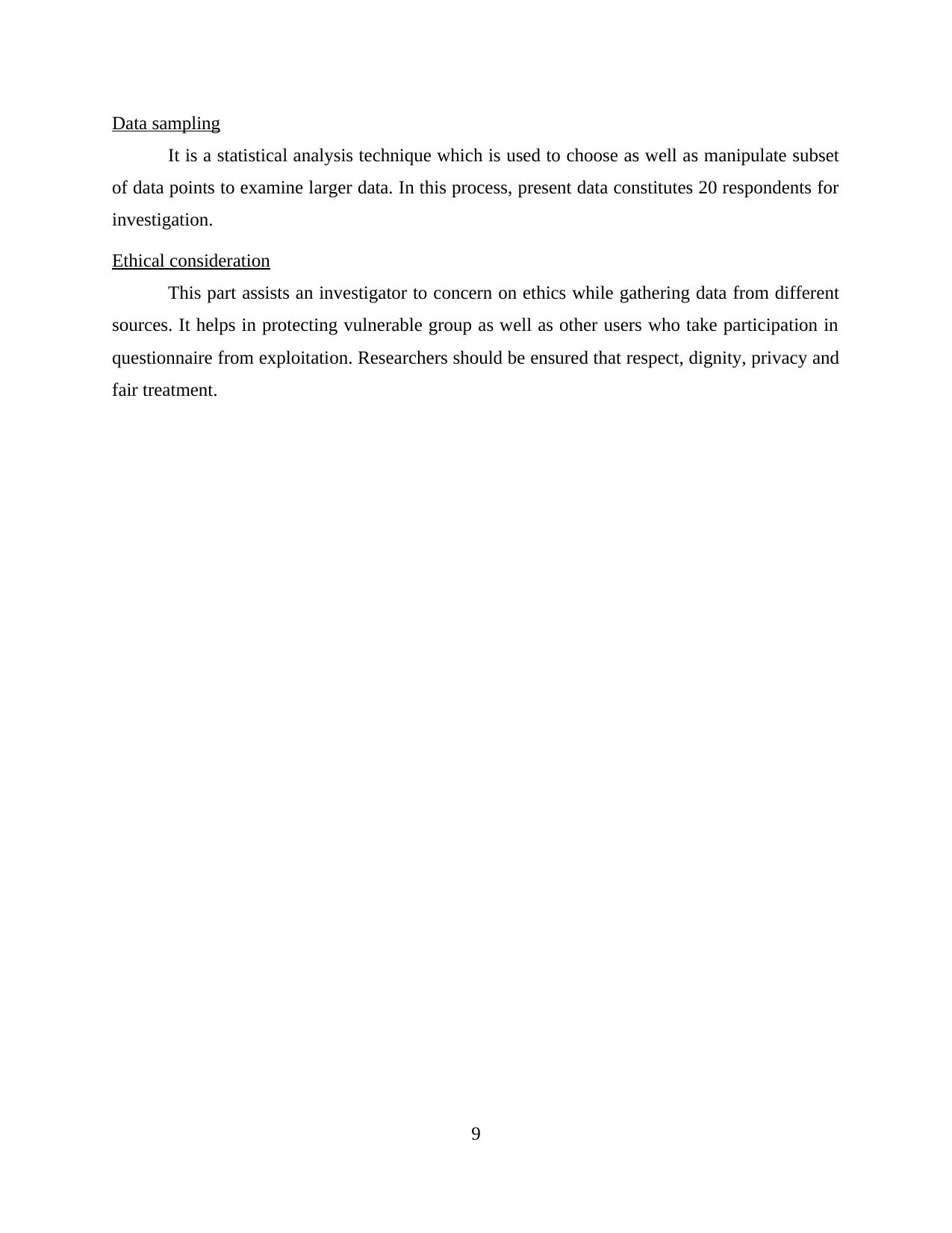
Data sampling
It is a statistical analysis technique which is used to choose as well as manipulate subset
of data points to examine larger data. In this process, present data constitutes 20 respondents for
investigation.
Ethical consideration
This part assists an investigator to concern on ethics while gathering data from different
sources. It helps in protecting vulnerable group as well as other users who take participation in
questionnaire from exploitation. Researchers should be ensured that respect, dignity, privacy and
fair treatment.
9
It is a statistical analysis technique which is used to choose as well as manipulate subset
of data points to examine larger data. In this process, present data constitutes 20 respondents for
investigation.
Ethical consideration
This part assists an investigator to concern on ethics while gathering data from different
sources. It helps in protecting vulnerable group as well as other users who take participation in
questionnaire from exploitation. Researchers should be ensured that respect, dignity, privacy and
fair treatment.
9
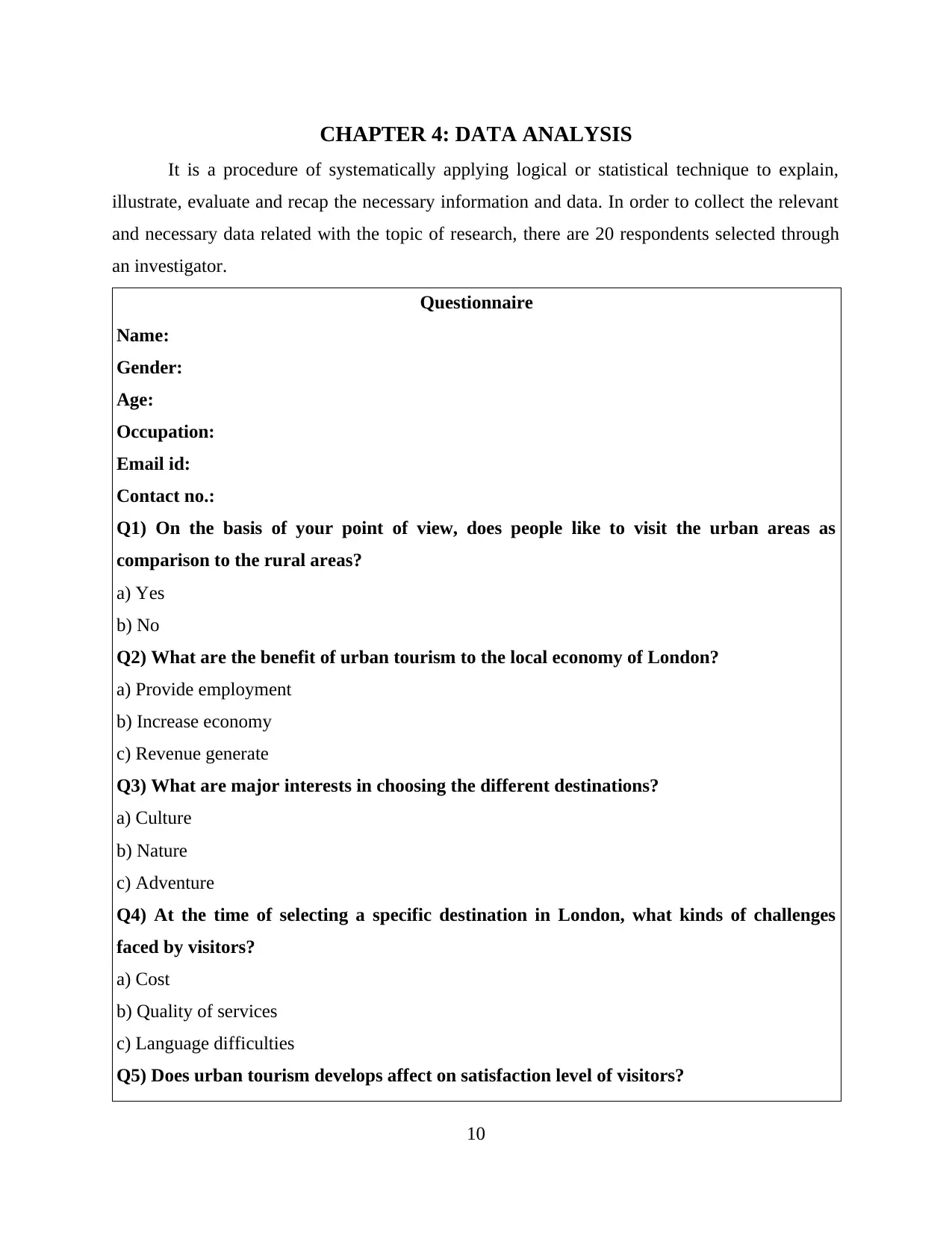
CHAPTER 4: DATA ANALYSIS
It is a procedure of systematically applying logical or statistical technique to explain,
illustrate, evaluate and recap the necessary information and data. In order to collect the relevant
and necessary data related with the topic of research, there are 20 respondents selected through
an investigator.
Questionnaire
Name:
Gender:
Age:
Occupation:
Email id:
Contact no.:
Q1) On the basis of your point of view, does people like to visit the urban areas as
comparison to the rural areas?
a) Yes
b) No
Q2) What are the benefit of urban tourism to the local economy of London?
a) Provide employment
b) Increase economy
c) Revenue generate
Q3) What are major interests in choosing the different destinations?
a) Culture
b) Nature
c) Adventure
Q4) At the time of selecting a specific destination in London, what kinds of challenges
faced by visitors?
a) Cost
b) Quality of services
c) Language difficulties
Q5) Does urban tourism develops affect on satisfaction level of visitors?
10
It is a procedure of systematically applying logical or statistical technique to explain,
illustrate, evaluate and recap the necessary information and data. In order to collect the relevant
and necessary data related with the topic of research, there are 20 respondents selected through
an investigator.
Questionnaire
Name:
Gender:
Age:
Occupation:
Email id:
Contact no.:
Q1) On the basis of your point of view, does people like to visit the urban areas as
comparison to the rural areas?
a) Yes
b) No
Q2) What are the benefit of urban tourism to the local economy of London?
a) Provide employment
b) Increase economy
c) Revenue generate
Q3) What are major interests in choosing the different destinations?
a) Culture
b) Nature
c) Adventure
Q4) At the time of selecting a specific destination in London, what kinds of challenges
faced by visitors?
a) Cost
b) Quality of services
c) Language difficulties
Q5) Does urban tourism develops affect on satisfaction level of visitors?
10
Paraphrase This Document
Need a fresh take? Get an instant paraphrase of this document with our AI Paraphraser
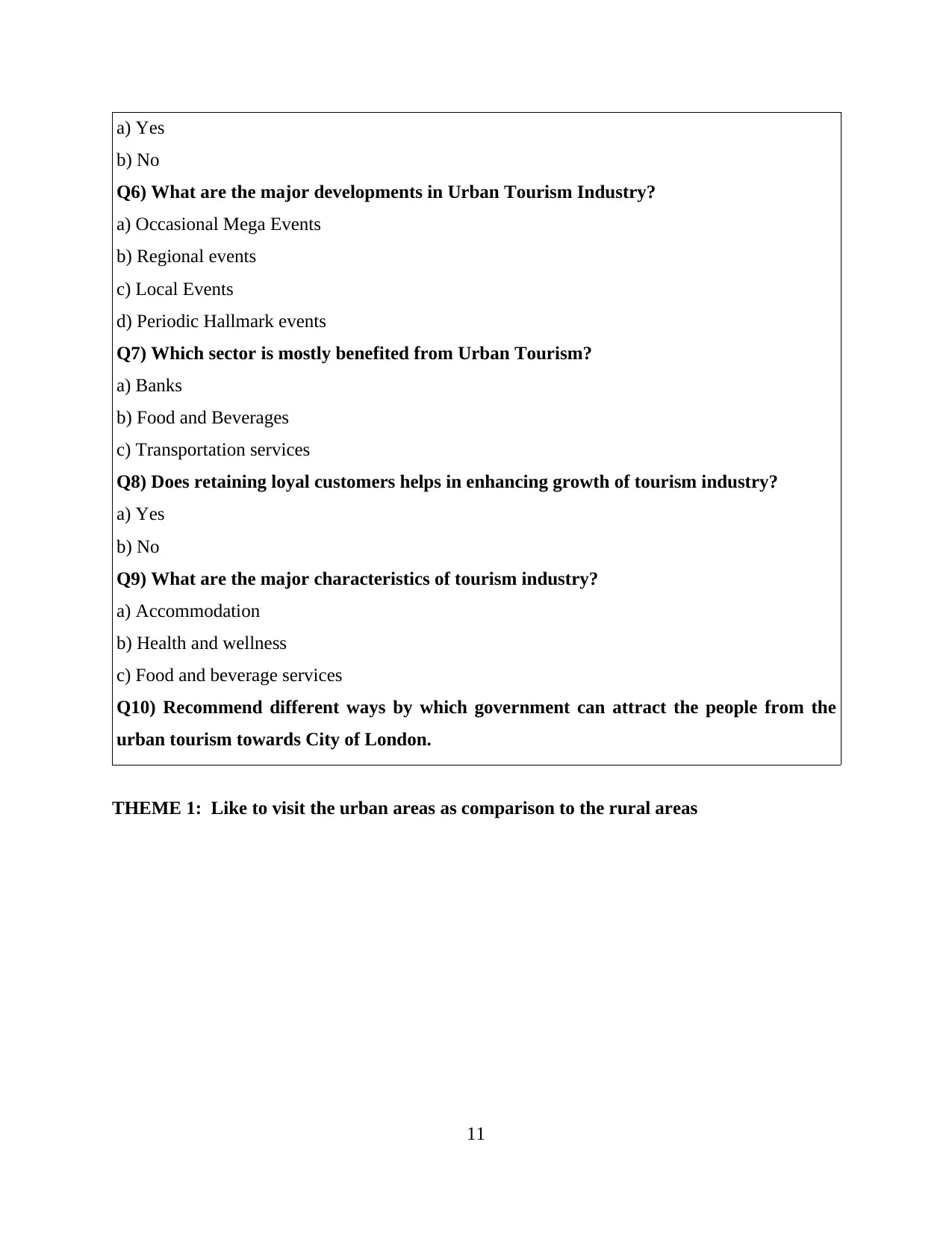
a) Yes
b) No
Q6) What are the major developments in Urban Tourism Industry?
a) Occasional Mega Events
b) Regional events
c) Local Events
d) Periodic Hallmark events
Q7) Which sector is mostly benefited from Urban Tourism?
a) Banks
b) Food and Beverages
c) Transportation services
Q8) Does retaining loyal customers helps in enhancing growth of tourism industry?
a) Yes
b) No
Q9) What are the major characteristics of tourism industry?
a) Accommodation
b) Health and wellness
c) Food and beverage services
Q10) Recommend different ways by which government can attract the people from the
urban tourism towards City of London.
THEME 1: Like to visit the urban areas as comparison to the rural areas
11
b) No
Q6) What are the major developments in Urban Tourism Industry?
a) Occasional Mega Events
b) Regional events
c) Local Events
d) Periodic Hallmark events
Q7) Which sector is mostly benefited from Urban Tourism?
a) Banks
b) Food and Beverages
c) Transportation services
Q8) Does retaining loyal customers helps in enhancing growth of tourism industry?
a) Yes
b) No
Q9) What are the major characteristics of tourism industry?
a) Accommodation
b) Health and wellness
c) Food and beverage services
Q10) Recommend different ways by which government can attract the people from the
urban tourism towards City of London.
THEME 1: Like to visit the urban areas as comparison to the rural areas
11

Q1) On the basis of your point of view, does
people like to visit the urban areas as
comparison to the rural areas?
Frequency
Yes 12
No 8
Interpretation: Travel is more in the urban areas as comparison to the rural areas because in the
urban areas, there is all kinds of facilities which help in travel the tourist freely. On the basis of
given graph, there are 12 respondents which said that people list to travel in the urban countries
than the rural. In urban areas, there are all the facilities which tourism organisations can provide
to the visitors. On the other hand, there are 8 other respondents which are not agree with this
given statement.
THEME 2: Benefit of urban tourism to the local economy of London
Q2) What are the benefit of urban tourism
to the local economy of London?
Frequency
Provide employment 8
Increase economy 5
Revenue generate 7
12
Yes No
0
2
4
6
8
10
12
12
8
Column B
people like to visit the urban areas as
comparison to the rural areas?
Frequency
Yes 12
No 8
Interpretation: Travel is more in the urban areas as comparison to the rural areas because in the
urban areas, there is all kinds of facilities which help in travel the tourist freely. On the basis of
given graph, there are 12 respondents which said that people list to travel in the urban countries
than the rural. In urban areas, there are all the facilities which tourism organisations can provide
to the visitors. On the other hand, there are 8 other respondents which are not agree with this
given statement.
THEME 2: Benefit of urban tourism to the local economy of London
Q2) What are the benefit of urban tourism
to the local economy of London?
Frequency
Provide employment 8
Increase economy 5
Revenue generate 7
12
Yes No
0
2
4
6
8
10
12
12
8
Column B
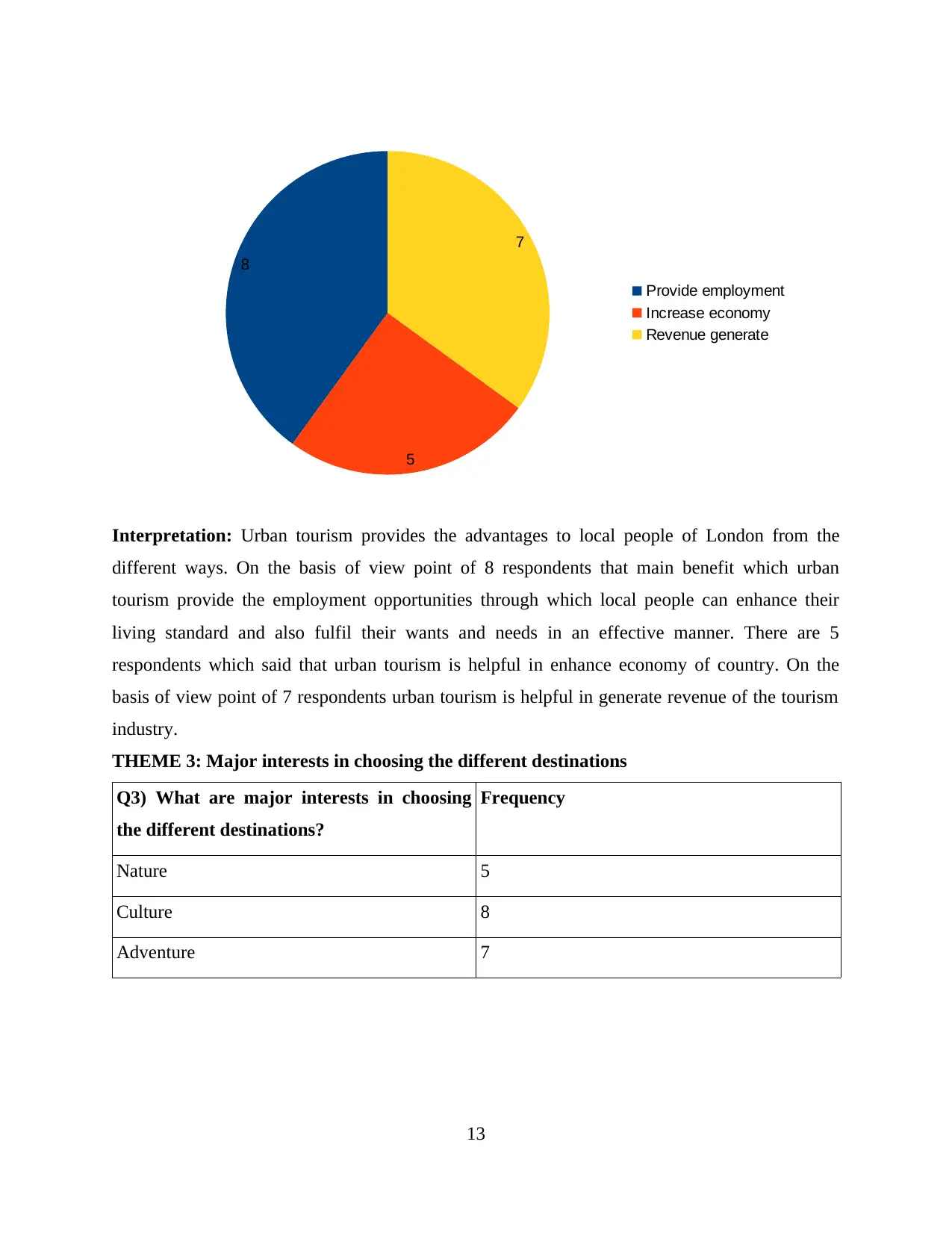
Interpretation: Urban tourism provides the advantages to local people of London from the
different ways. On the basis of view point of 8 respondents that main benefit which urban
tourism provide the employment opportunities through which local people can enhance their
living standard and also fulfil their wants and needs in an effective manner. There are 5
respondents which said that urban tourism is helpful in enhance economy of country. On the
basis of view point of 7 respondents urban tourism is helpful in generate revenue of the tourism
industry.
THEME 3: Major interests in choosing the different destinations
Q3) What are major interests in choosing
the different destinations?
Frequency
Nature 5
Culture 8
Adventure 7
13
8
5
7
Provide employment
Increase economy
Revenue generate
different ways. On the basis of view point of 8 respondents that main benefit which urban
tourism provide the employment opportunities through which local people can enhance their
living standard and also fulfil their wants and needs in an effective manner. There are 5
respondents which said that urban tourism is helpful in enhance economy of country. On the
basis of view point of 7 respondents urban tourism is helpful in generate revenue of the tourism
industry.
THEME 3: Major interests in choosing the different destinations
Q3) What are major interests in choosing
the different destinations?
Frequency
Nature 5
Culture 8
Adventure 7
13
8
5
7
Provide employment
Increase economy
Revenue generate
Secure Best Marks with AI Grader
Need help grading? Try our AI Grader for instant feedback on your assignments.
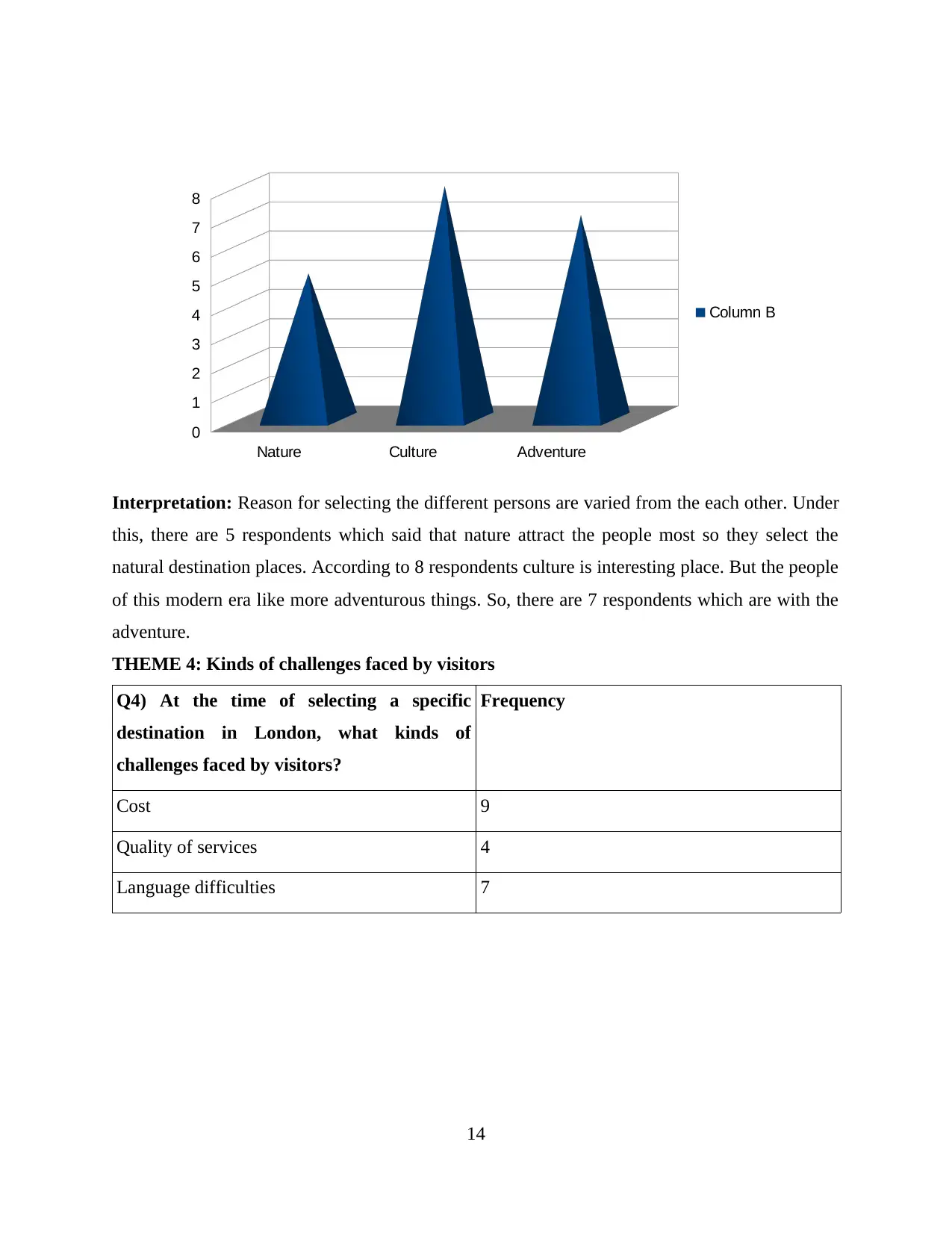
Interpretation: Reason for selecting the different persons are varied from the each other. Under
this, there are 5 respondents which said that nature attract the people most so they select the
natural destination places. According to 8 respondents culture is interesting place. But the people
of this modern era like more adventurous things. So, there are 7 respondents which are with the
adventure.
THEME 4: Kinds of challenges faced by visitors
Q4) At the time of selecting a specific
destination in London, what kinds of
challenges faced by visitors?
Frequency
Cost 9
Quality of services 4
Language difficulties 7
14
Nature Culture Adventure
0
1
2
3
4
5
6
7
8
Column B
this, there are 5 respondents which said that nature attract the people most so they select the
natural destination places. According to 8 respondents culture is interesting place. But the people
of this modern era like more adventurous things. So, there are 7 respondents which are with the
adventure.
THEME 4: Kinds of challenges faced by visitors
Q4) At the time of selecting a specific
destination in London, what kinds of
challenges faced by visitors?
Frequency
Cost 9
Quality of services 4
Language difficulties 7
14
Nature Culture Adventure
0
1
2
3
4
5
6
7
8
Column B
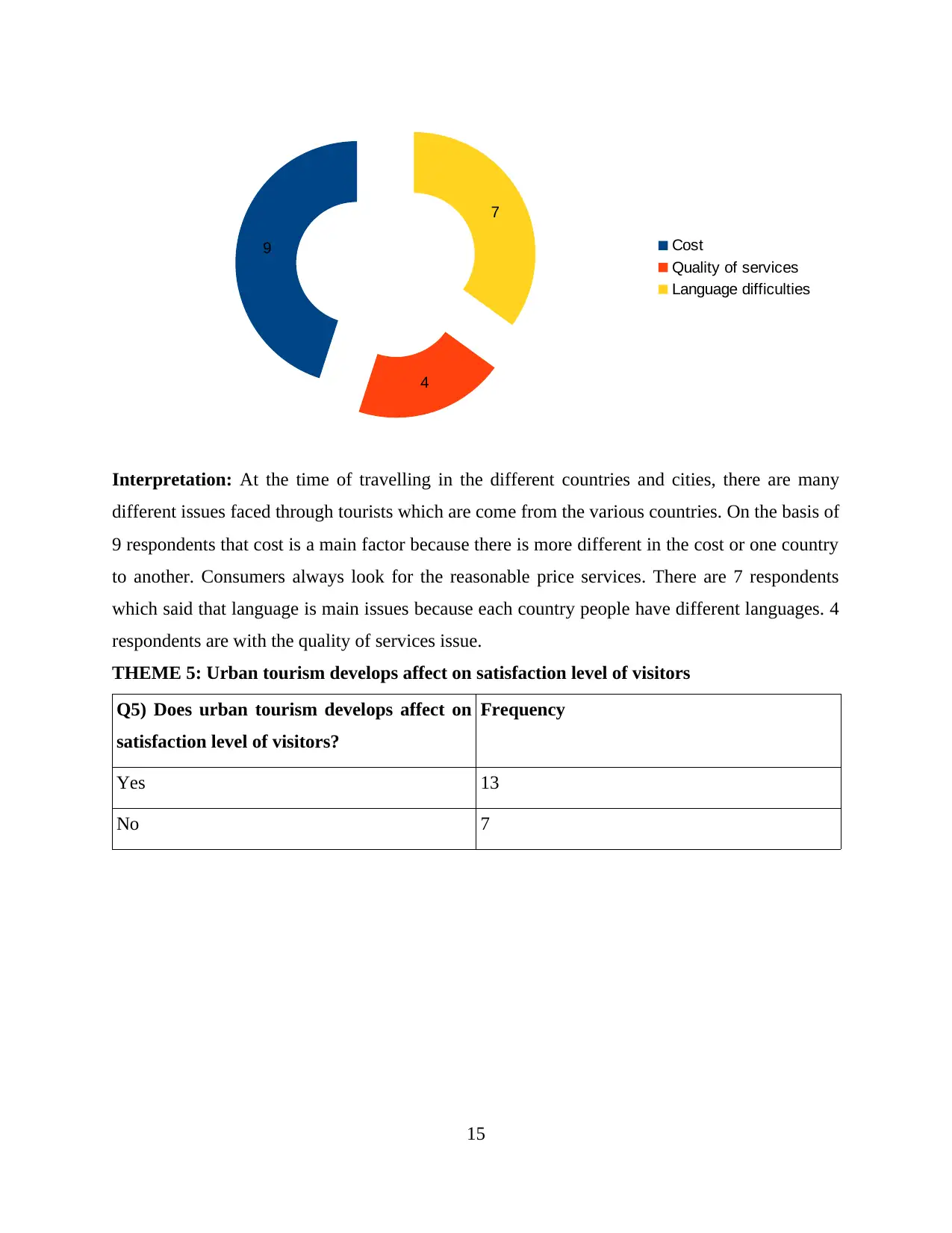
Interpretation: At the time of travelling in the different countries and cities, there are many
different issues faced through tourists which are come from the various countries. On the basis of
9 respondents that cost is a main factor because there is more different in the cost or one country
to another. Consumers always look for the reasonable price services. There are 7 respondents
which said that language is main issues because each country people have different languages. 4
respondents are with the quality of services issue.
THEME 5: Urban tourism develops affect on satisfaction level of visitors
Q5) Does urban tourism develops affect on
satisfaction level of visitors?
Frequency
Yes 13
No 7
15
9
4
7
Cost
Quality of services
Language difficulties
9
4
7
Cost
Quality of services
Language difficulties
different issues faced through tourists which are come from the various countries. On the basis of
9 respondents that cost is a main factor because there is more different in the cost or one country
to another. Consumers always look for the reasonable price services. There are 7 respondents
which said that language is main issues because each country people have different languages. 4
respondents are with the quality of services issue.
THEME 5: Urban tourism develops affect on satisfaction level of visitors
Q5) Does urban tourism develops affect on
satisfaction level of visitors?
Frequency
Yes 13
No 7
15
9
4
7
Cost
Quality of services
Language difficulties
9
4
7
Cost
Quality of services
Language difficulties
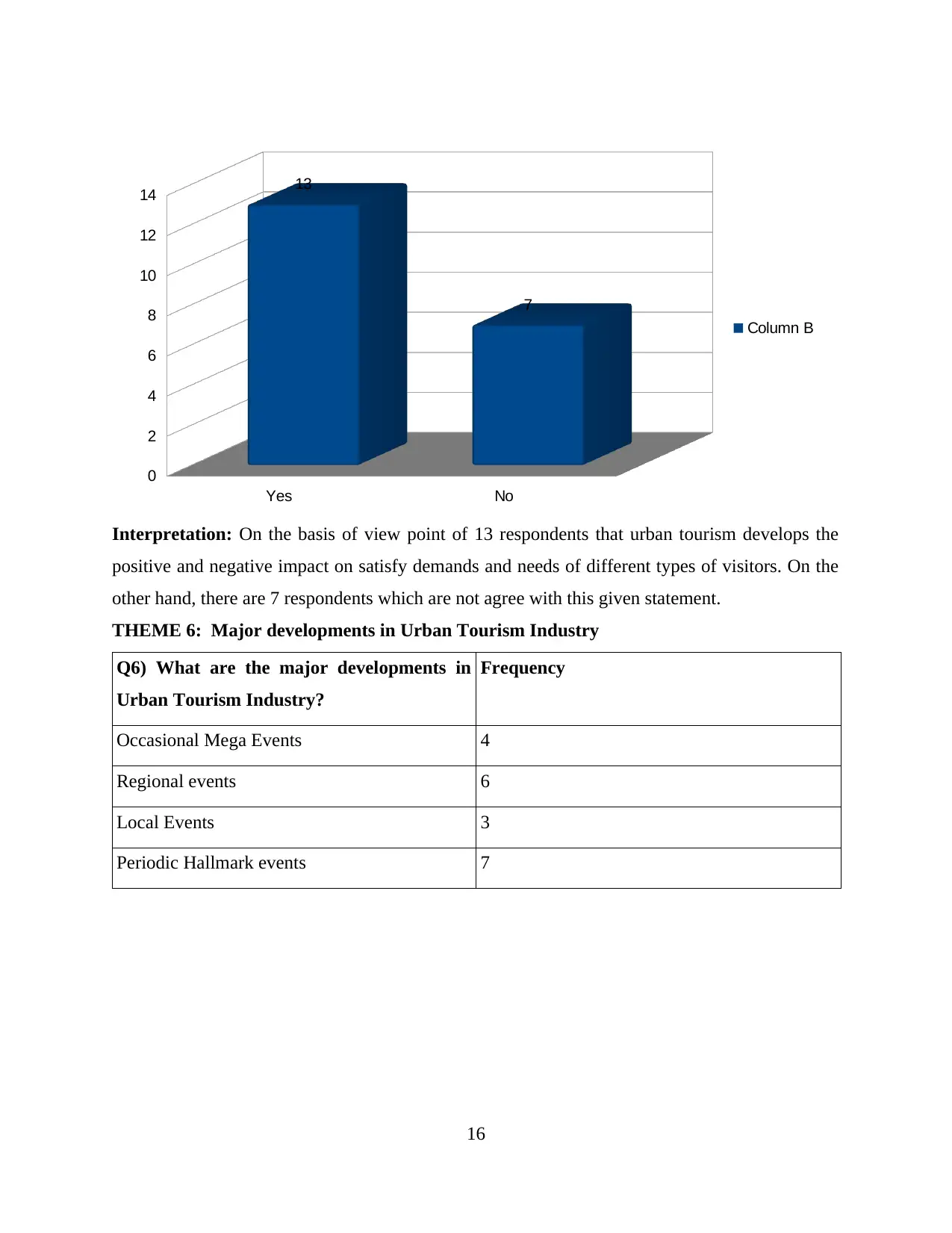
Interpretation: On the basis of view point of 13 respondents that urban tourism develops the
positive and negative impact on satisfy demands and needs of different types of visitors. On the
other hand, there are 7 respondents which are not agree with this given statement.
THEME 6: Major developments in Urban Tourism Industry
Q6) What are the major developments in
Urban Tourism Industry?
Frequency
Occasional Mega Events 4
Regional events 6
Local Events 3
Periodic Hallmark events 7
16
Yes No
0
2
4
6
8
10
12
14 13
7
Column B
positive and negative impact on satisfy demands and needs of different types of visitors. On the
other hand, there are 7 respondents which are not agree with this given statement.
THEME 6: Major developments in Urban Tourism Industry
Q6) What are the major developments in
Urban Tourism Industry?
Frequency
Occasional Mega Events 4
Regional events 6
Local Events 3
Periodic Hallmark events 7
16
Yes No
0
2
4
6
8
10
12
14 13
7
Column B
Paraphrase This Document
Need a fresh take? Get an instant paraphrase of this document with our AI Paraphraser
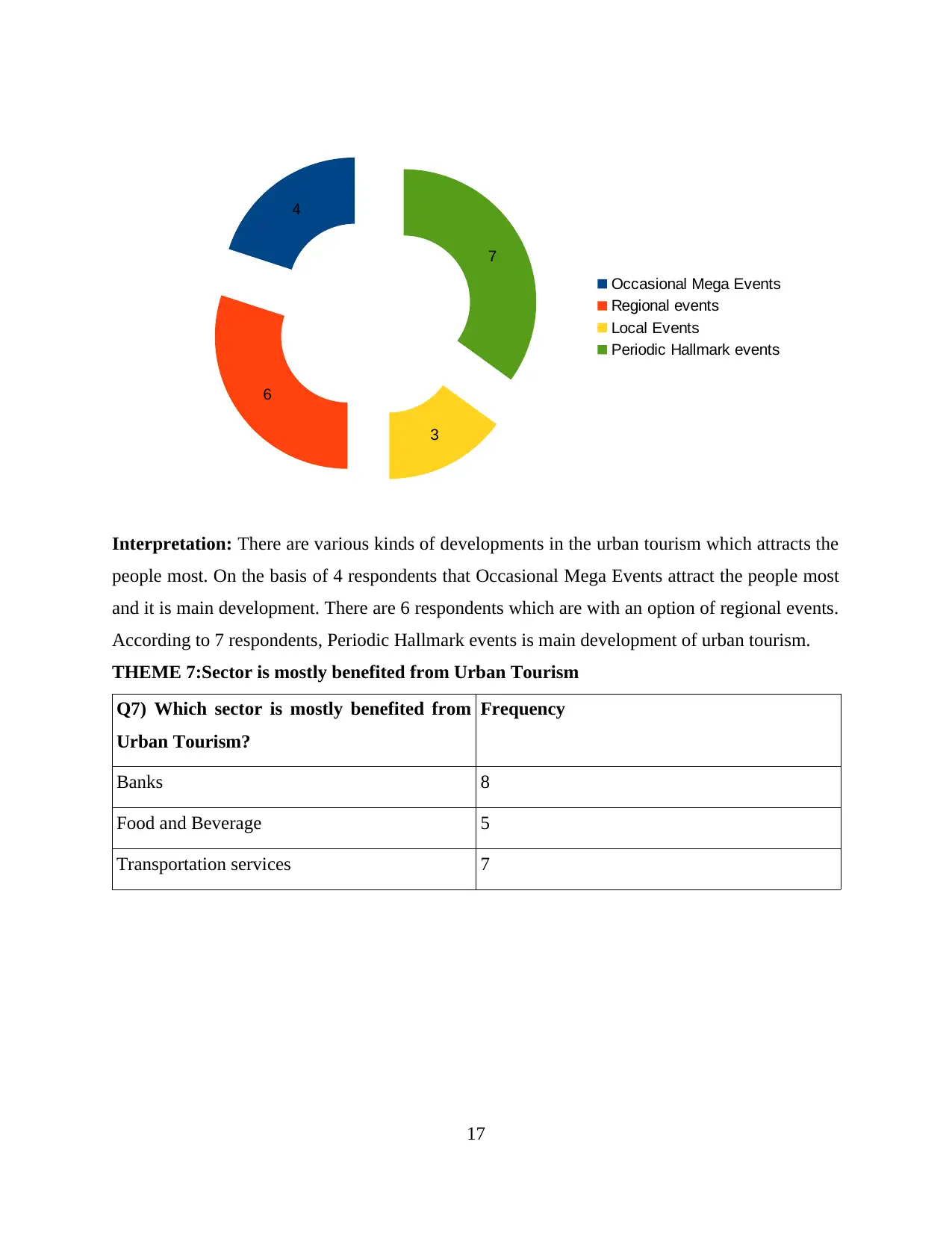
Interpretation: There are various kinds of developments in the urban tourism which attracts the
people most. On the basis of 4 respondents that Occasional Mega Events attract the people most
and it is main development. There are 6 respondents which are with an option of regional events.
According to 7 respondents, Periodic Hallmark events is main development of urban tourism.
THEME 7:Sector is mostly benefited from Urban Tourism
Q7) Which sector is mostly benefited from
Urban Tourism?
Frequency
Banks 8
Food and Beverage 5
Transportation services 7
17
4
6
3
7
Occasional Mega Events
Regional events
Local Events
Periodic Hallmark events
people most. On the basis of 4 respondents that Occasional Mega Events attract the people most
and it is main development. There are 6 respondents which are with an option of regional events.
According to 7 respondents, Periodic Hallmark events is main development of urban tourism.
THEME 7:Sector is mostly benefited from Urban Tourism
Q7) Which sector is mostly benefited from
Urban Tourism?
Frequency
Banks 8
Food and Beverage 5
Transportation services 7
17
4
6
3
7
Occasional Mega Events
Regional events
Local Events
Periodic Hallmark events
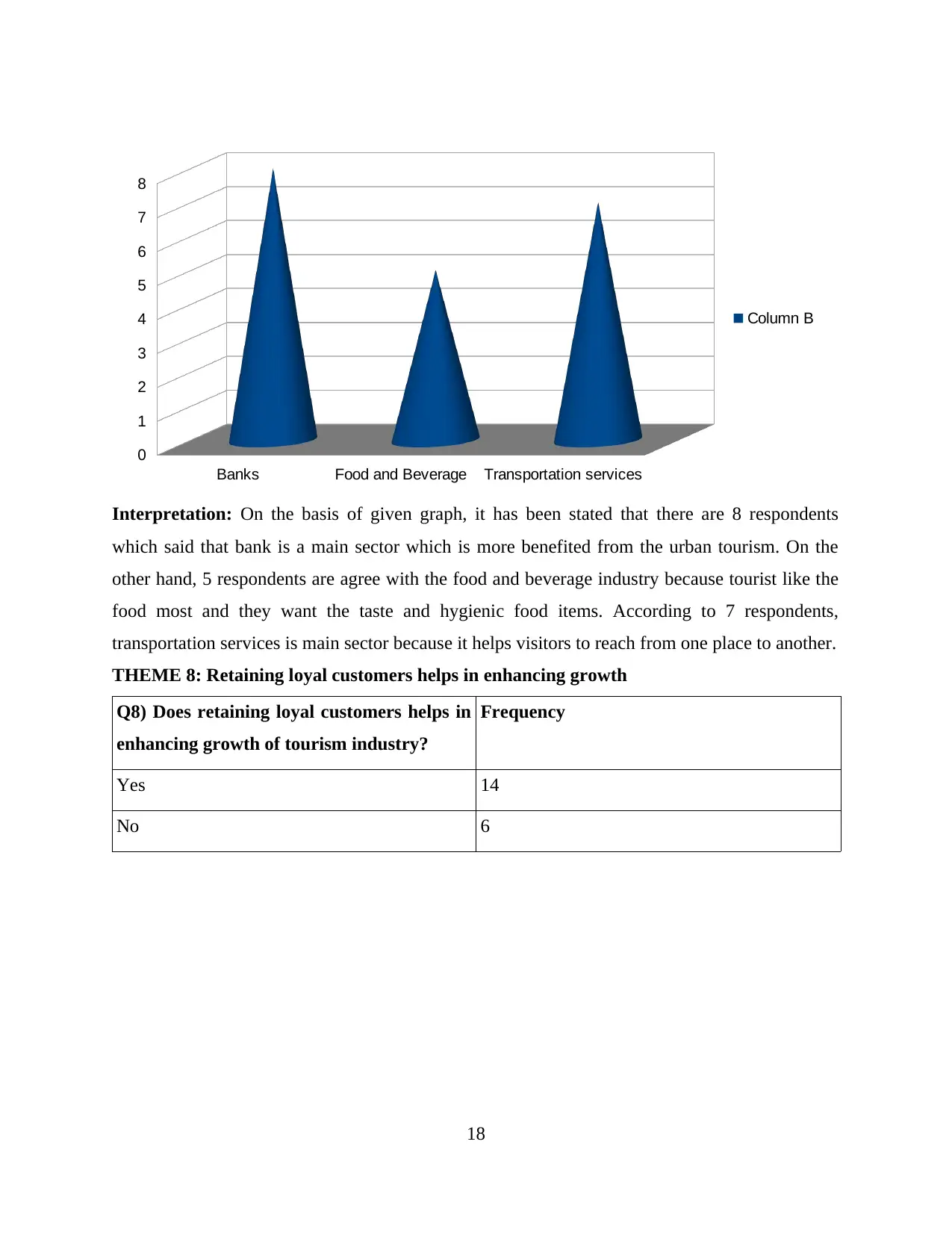
Interpretation: On the basis of given graph, it has been stated that there are 8 respondents
which said that bank is a main sector which is more benefited from the urban tourism. On the
other hand, 5 respondents are agree with the food and beverage industry because tourist like the
food most and they want the taste and hygienic food items. According to 7 respondents,
transportation services is main sector because it helps visitors to reach from one place to another.
THEME 8: Retaining loyal customers helps in enhancing growth
Q8) Does retaining loyal customers helps in
enhancing growth of tourism industry?
Frequency
Yes 14
No 6
18
Banks Food and Beverage Transportation services
0
1
2
3
4
5
6
7
8
Column B
which said that bank is a main sector which is more benefited from the urban tourism. On the
other hand, 5 respondents are agree with the food and beverage industry because tourist like the
food most and they want the taste and hygienic food items. According to 7 respondents,
transportation services is main sector because it helps visitors to reach from one place to another.
THEME 8: Retaining loyal customers helps in enhancing growth
Q8) Does retaining loyal customers helps in
enhancing growth of tourism industry?
Frequency
Yes 14
No 6
18
Banks Food and Beverage Transportation services
0
1
2
3
4
5
6
7
8
Column B
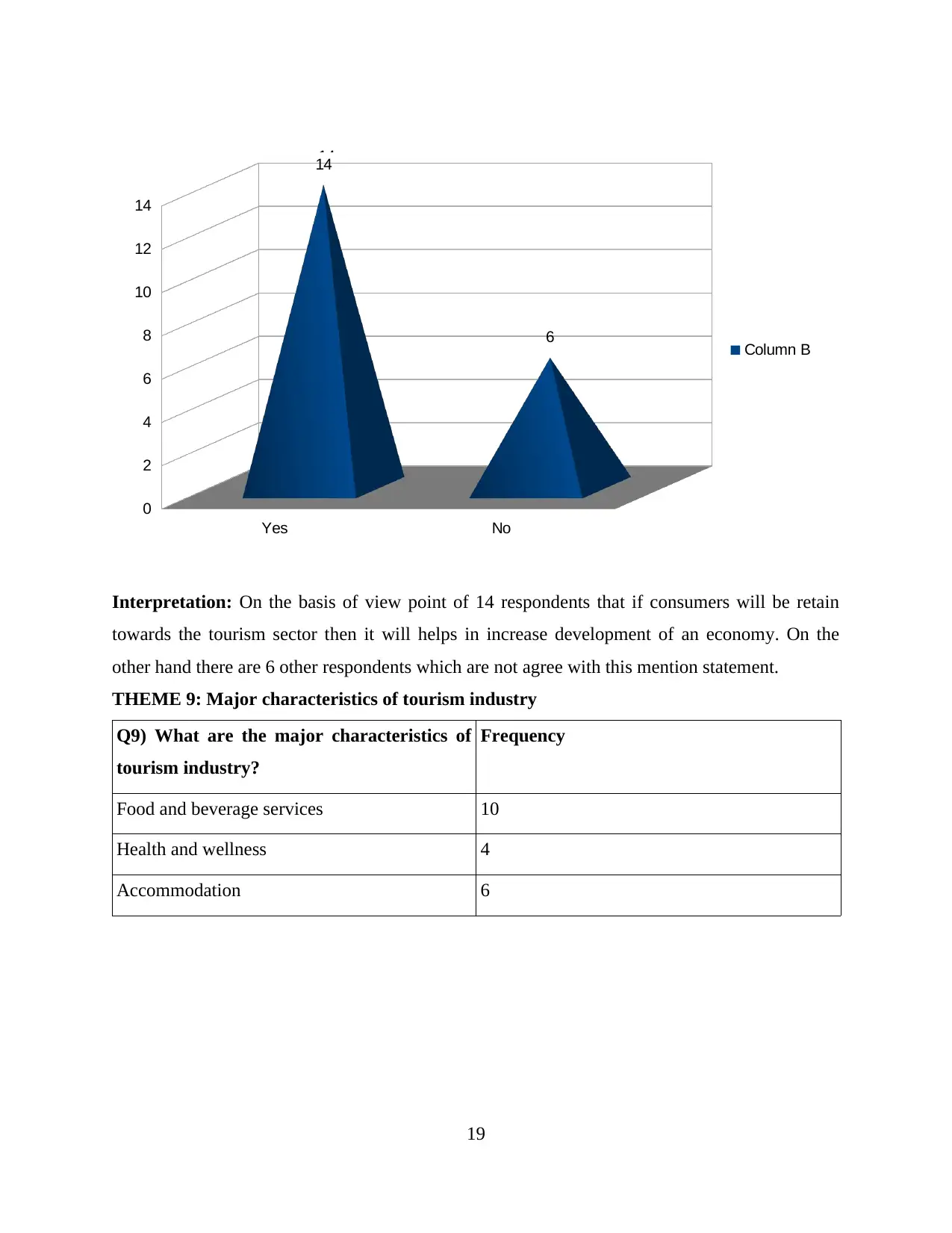
Interpretation: On the basis of view point of 14 respondents that if consumers will be retain
towards the tourism sector then it will helps in increase development of an economy. On the
other hand there are 6 other respondents which are not agree with this mention statement.
THEME 9: Major characteristics of tourism industry
Q9) What are the major characteristics of
tourism industry?
Frequency
Food and beverage services 10
Health and wellness 4
Accommodation 6
19
Yes No
0
2
4
6
8
10
12
14
14
6 Column B
Yes No
0
2
4
6
8
10
12
14
14
6 Column B
towards the tourism sector then it will helps in increase development of an economy. On the
other hand there are 6 other respondents which are not agree with this mention statement.
THEME 9: Major characteristics of tourism industry
Q9) What are the major characteristics of
tourism industry?
Frequency
Food and beverage services 10
Health and wellness 4
Accommodation 6
19
Yes No
0
2
4
6
8
10
12
14
14
6 Column B
Yes No
0
2
4
6
8
10
12
14
14
6 Column B
Secure Best Marks with AI Grader
Need help grading? Try our AI Grader for instant feedback on your assignments.
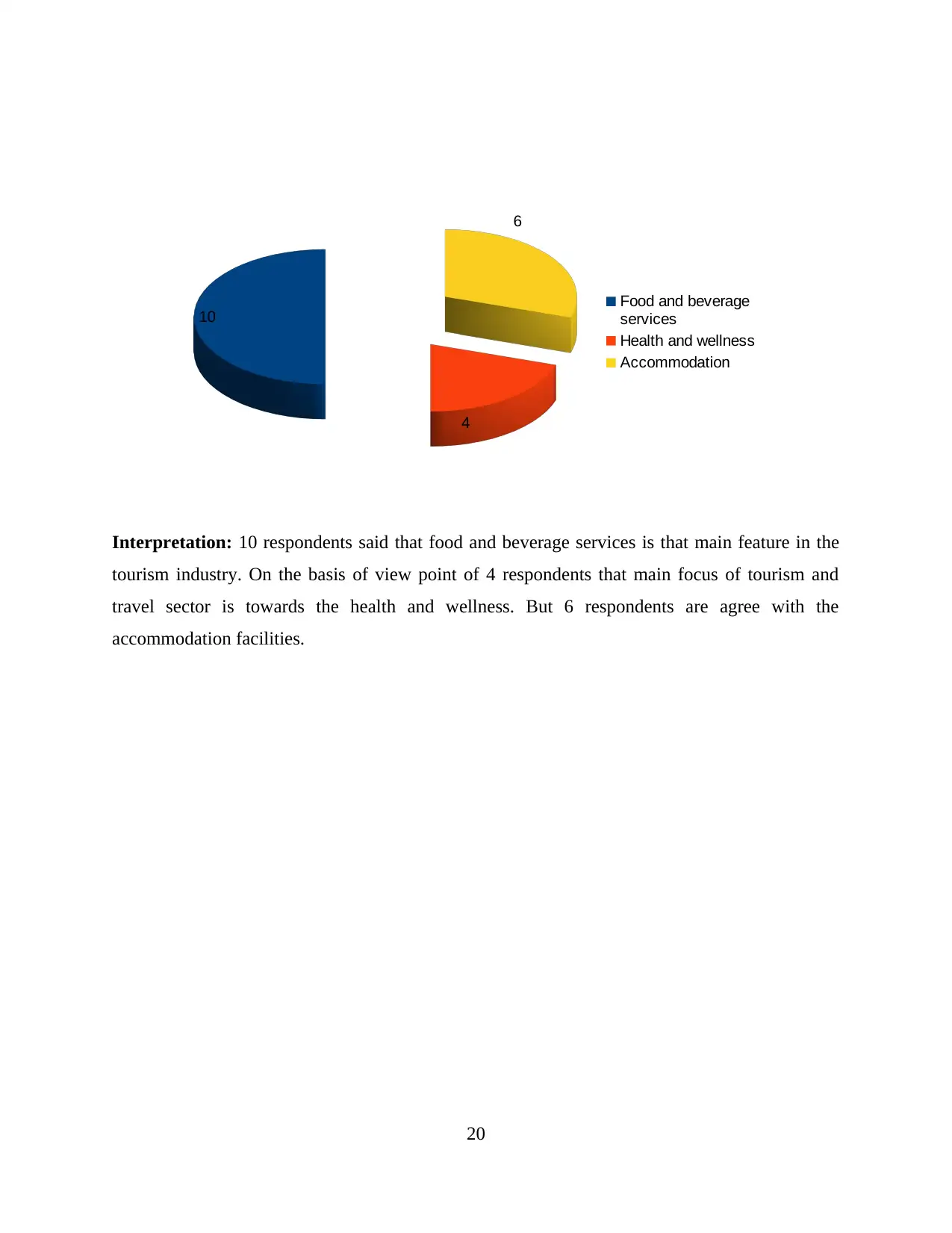
Interpretation: 10 respondents said that food and beverage services is that main feature in the
tourism industry. On the basis of view point of 4 respondents that main focus of tourism and
travel sector is towards the health and wellness. But 6 respondents are agree with the
accommodation facilities.
20
10
4
6
Food and beverage
services
Health and wellness
Accommodation
tourism industry. On the basis of view point of 4 respondents that main focus of tourism and
travel sector is towards the health and wellness. But 6 respondents are agree with the
accommodation facilities.
20
10
4
6
Food and beverage
services
Health and wellness
Accommodation
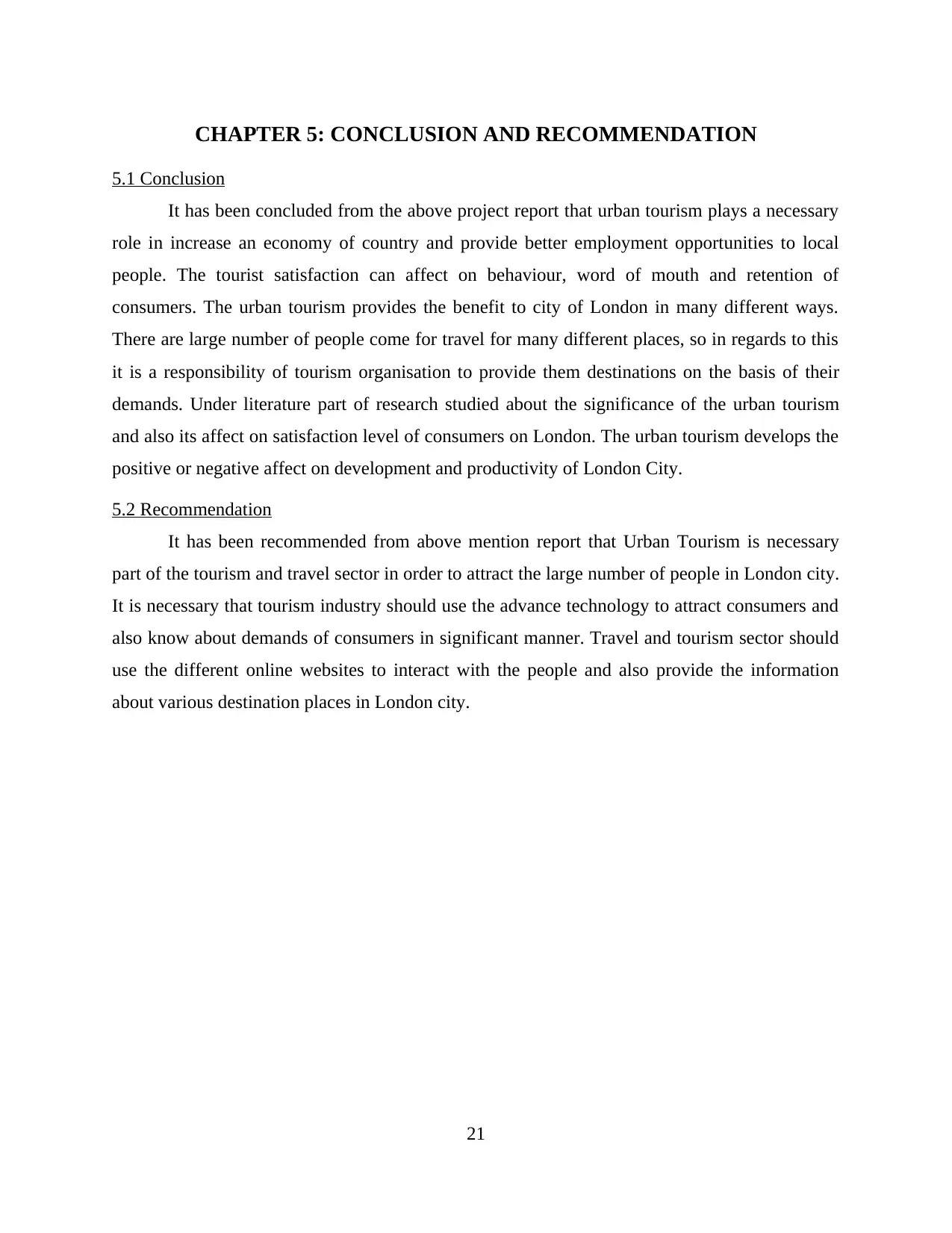
CHAPTER 5: CONCLUSION AND RECOMMENDATION
5.1 Conclusion
It has been concluded from the above project report that urban tourism plays a necessary
role in increase an economy of country and provide better employment opportunities to local
people. The tourist satisfaction can affect on behaviour, word of mouth and retention of
consumers. The urban tourism provides the benefit to city of London in many different ways.
There are large number of people come for travel for many different places, so in regards to this
it is a responsibility of tourism organisation to provide them destinations on the basis of their
demands. Under literature part of research studied about the significance of the urban tourism
and also its affect on satisfaction level of consumers on London. The urban tourism develops the
positive or negative affect on development and productivity of London City.
5.2 Recommendation
It has been recommended from above mention report that Urban Tourism is necessary
part of the tourism and travel sector in order to attract the large number of people in London city.
It is necessary that tourism industry should use the advance technology to attract consumers and
also know about demands of consumers in significant manner. Travel and tourism sector should
use the different online websites to interact with the people and also provide the information
about various destination places in London city.
21
5.1 Conclusion
It has been concluded from the above project report that urban tourism plays a necessary
role in increase an economy of country and provide better employment opportunities to local
people. The tourist satisfaction can affect on behaviour, word of mouth and retention of
consumers. The urban tourism provides the benefit to city of London in many different ways.
There are large number of people come for travel for many different places, so in regards to this
it is a responsibility of tourism organisation to provide them destinations on the basis of their
demands. Under literature part of research studied about the significance of the urban tourism
and also its affect on satisfaction level of consumers on London. The urban tourism develops the
positive or negative affect on development and productivity of London City.
5.2 Recommendation
It has been recommended from above mention report that Urban Tourism is necessary
part of the tourism and travel sector in order to attract the large number of people in London city.
It is necessary that tourism industry should use the advance technology to attract consumers and
also know about demands of consumers in significant manner. Travel and tourism sector should
use the different online websites to interact with the people and also provide the information
about various destination places in London city.
21
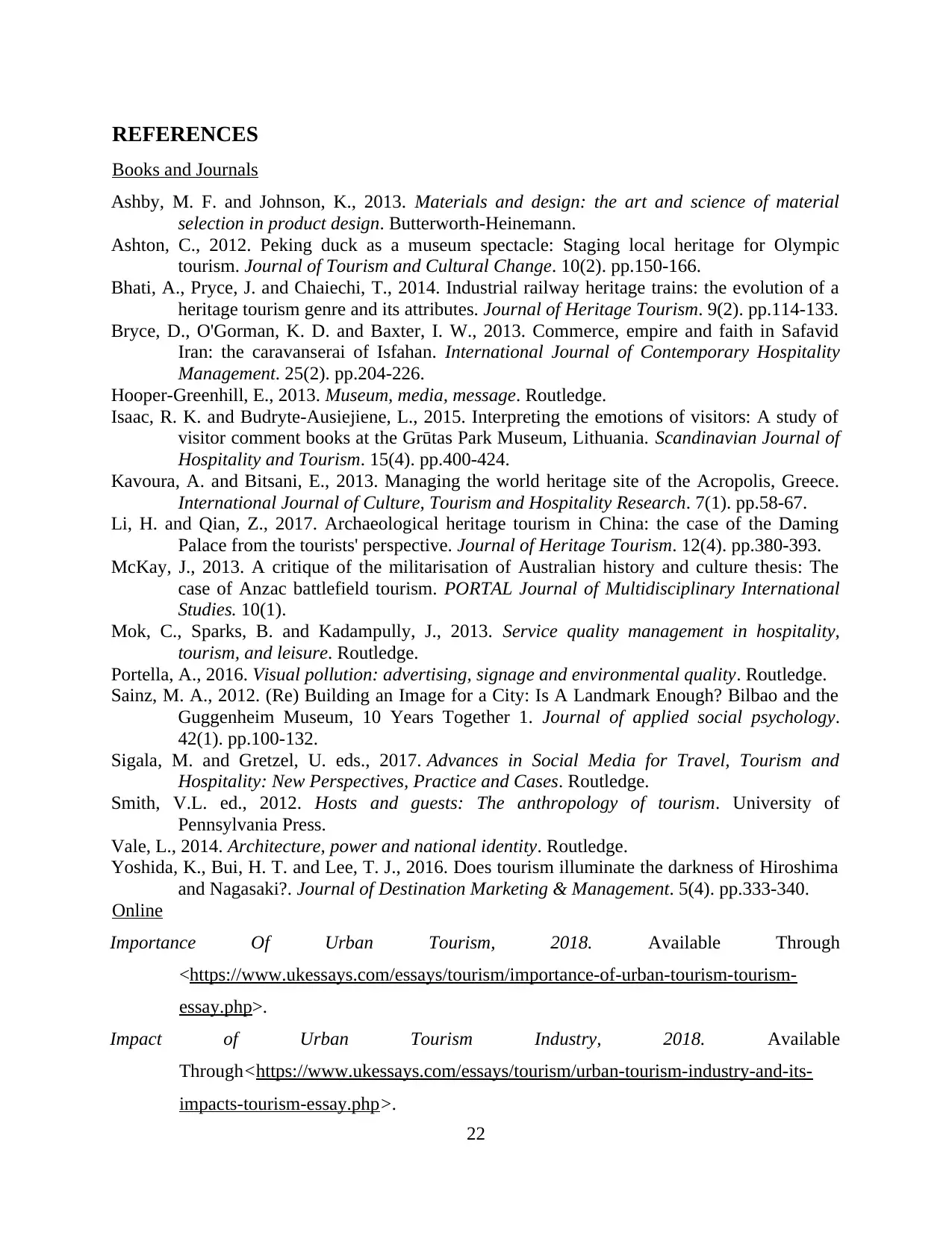
REFERENCES
Books and Journals
Ashby, M. F. and Johnson, K., 2013. Materials and design: the art and science of material
selection in product design. Butterworth-Heinemann.
Ashton, C., 2012. Peking duck as a museum spectacle: Staging local heritage for Olympic
tourism. Journal of Tourism and Cultural Change. 10(2). pp.150-166.
Bhati, A., Pryce, J. and Chaiechi, T., 2014. Industrial railway heritage trains: the evolution of a
heritage tourism genre and its attributes. Journal of Heritage Tourism. 9(2). pp.114-133.
Bryce, D., O'Gorman, K. D. and Baxter, I. W., 2013. Commerce, empire and faith in Safavid
Iran: the caravanserai of Isfahan. International Journal of Contemporary Hospitality
Management. 25(2). pp.204-226.
Hooper-Greenhill, E., 2013. Museum, media, message. Routledge.
Isaac, R. K. and Budryte-Ausiejiene, L., 2015. Interpreting the emotions of visitors: A study of
visitor comment books at the Grūtas Park Museum, Lithuania. Scandinavian Journal of
Hospitality and Tourism. 15(4). pp.400-424.
Kavoura, A. and Bitsani, E., 2013. Managing the world heritage site of the Acropolis, Greece.
International Journal of Culture, Tourism and Hospitality Research. 7(1). pp.58-67.
Li, H. and Qian, Z., 2017. Archaeological heritage tourism in China: the case of the Daming
Palace from the tourists' perspective. Journal of Heritage Tourism. 12(4). pp.380-393.
McKay, J., 2013. A critique of the militarisation of Australian history and culture thesis: The
case of Anzac battlefield tourism. PORTAL Journal of Multidisciplinary International
Studies. 10(1).
Mok, C., Sparks, B. and Kadampully, J., 2013. Service quality management in hospitality,
tourism, and leisure. Routledge.
Portella, A., 2016. Visual pollution: advertising, signage and environmental quality. Routledge.
Sainz, M. A., 2012. (Re) Building an Image for a City: Is A Landmark Enough? Bilbao and the
Guggenheim Museum, 10 Years Together 1. Journal of applied social psychology.
42(1). pp.100-132.
Sigala, M. and Gretzel, U. eds., 2017. Advances in Social Media for Travel, Tourism and
Hospitality: New Perspectives, Practice and Cases. Routledge.
Smith, V.L. ed., 2012. Hosts and guests: The anthropology of tourism. University of
Pennsylvania Press.
Vale, L., 2014. Architecture, power and national identity. Routledge.
Yoshida, K., Bui, H. T. and Lee, T. J., 2016. Does tourism illuminate the darkness of Hiroshima
and Nagasaki?. Journal of Destination Marketing & Management. 5(4). pp.333-340.
Online
Importance Of Urban Tourism, 2018. Available Through
<https://www.ukessays.com/essays/tourism/importance-of-urban-tourism-tourism-
essay.php>.
Impact of Urban Tourism Industry, 2018. Available
Through<https://www.ukessays.com/essays/tourism/urban-tourism-industry-and-its-
impacts-tourism-essay.php>.
22
Books and Journals
Ashby, M. F. and Johnson, K., 2013. Materials and design: the art and science of material
selection in product design. Butterworth-Heinemann.
Ashton, C., 2012. Peking duck as a museum spectacle: Staging local heritage for Olympic
tourism. Journal of Tourism and Cultural Change. 10(2). pp.150-166.
Bhati, A., Pryce, J. and Chaiechi, T., 2014. Industrial railway heritage trains: the evolution of a
heritage tourism genre and its attributes. Journal of Heritage Tourism. 9(2). pp.114-133.
Bryce, D., O'Gorman, K. D. and Baxter, I. W., 2013. Commerce, empire and faith in Safavid
Iran: the caravanserai of Isfahan. International Journal of Contemporary Hospitality
Management. 25(2). pp.204-226.
Hooper-Greenhill, E., 2013. Museum, media, message. Routledge.
Isaac, R. K. and Budryte-Ausiejiene, L., 2015. Interpreting the emotions of visitors: A study of
visitor comment books at the Grūtas Park Museum, Lithuania. Scandinavian Journal of
Hospitality and Tourism. 15(4). pp.400-424.
Kavoura, A. and Bitsani, E., 2013. Managing the world heritage site of the Acropolis, Greece.
International Journal of Culture, Tourism and Hospitality Research. 7(1). pp.58-67.
Li, H. and Qian, Z., 2017. Archaeological heritage tourism in China: the case of the Daming
Palace from the tourists' perspective. Journal of Heritage Tourism. 12(4). pp.380-393.
McKay, J., 2013. A critique of the militarisation of Australian history and culture thesis: The
case of Anzac battlefield tourism. PORTAL Journal of Multidisciplinary International
Studies. 10(1).
Mok, C., Sparks, B. and Kadampully, J., 2013. Service quality management in hospitality,
tourism, and leisure. Routledge.
Portella, A., 2016. Visual pollution: advertising, signage and environmental quality. Routledge.
Sainz, M. A., 2012. (Re) Building an Image for a City: Is A Landmark Enough? Bilbao and the
Guggenheim Museum, 10 Years Together 1. Journal of applied social psychology.
42(1). pp.100-132.
Sigala, M. and Gretzel, U. eds., 2017. Advances in Social Media for Travel, Tourism and
Hospitality: New Perspectives, Practice and Cases. Routledge.
Smith, V.L. ed., 2012. Hosts and guests: The anthropology of tourism. University of
Pennsylvania Press.
Vale, L., 2014. Architecture, power and national identity. Routledge.
Yoshida, K., Bui, H. T. and Lee, T. J., 2016. Does tourism illuminate the darkness of Hiroshima
and Nagasaki?. Journal of Destination Marketing & Management. 5(4). pp.333-340.
Online
Importance Of Urban Tourism, 2018. Available Through
<https://www.ukessays.com/essays/tourism/importance-of-urban-tourism-tourism-
essay.php>.
Impact of Urban Tourism Industry, 2018. Available
Through<https://www.ukessays.com/essays/tourism/urban-tourism-industry-and-its-
impacts-tourism-essay.php>.
22
Paraphrase This Document
Need a fresh take? Get an instant paraphrase of this document with our AI Paraphraser

23
1 out of 26
Related Documents
Your All-in-One AI-Powered Toolkit for Academic Success.
+13062052269
info@desklib.com
Available 24*7 on WhatsApp / Email
![[object Object]](/_next/static/media/star-bottom.7253800d.svg)
Unlock your academic potential
© 2024 | Zucol Services PVT LTD | All rights reserved.





